Federal Agency for Education Ural State Technical University - UPI
A. M. Dubinin
SOURCES AND HEAT SUPPLY SYSTEMS FOR INDUSTRIAL ENTERPRISES
Textbook for students of all forms of study
Scientific editor - Dr. Tech. sciences, prof. N. F. Filippovsky
Ekaterinburg
UDC 697.34(075.8) BBK 31.35 i 73 V 60
Reviewers: Associate Professor, Candidate of Sciences tech. Sciences Yu. V. Kuznetsov (Engineering and Pedagogical University); Associate Professor, Candidate of Sciences Tech. Sciences S.V. Zvyagin (Ural Forestry Academy).
Dubinin A. M.
D 79 Heat sources and systems industrial enterprises: textbook allowance / A. M. Dubinin. Ekaterinburg: USTU-UPI, 2007. 161 p.
ISBN 5-274-00523-3
The textbook is compiled on the basis of the State Educational Standards of specialties 140104 - Industrial Heat and Power Engineering and 140106 - Energy Supply of Enterprises. Represents summary course of lectures, which is given to students in the 6th, 7th and 8th semesters.
The issues of heat consumption by industrial enterprises, hydraulic and thermal calculations of heating networks are considered in detail. Given thermal circuits industrial boiler houses and combined heat and power plants, methods for their calculation and selection of main and auxiliary equipment, regulation of thermal power supplied to heat consumers. The issues of energy saving in heat supply systems are considered.
The manual is intended for students of all forms of study in specialties 140104 - Industrial Heat and Power Engineering and 140106 - Energy Supply of Enterprises.
Bibliography: 36 titles. Table 4. Fig. 34.
Prepared by the Department of Industrial Thermal Power Engineering
INTRODUCTION………………………………………………………………………………..…5
1. CLASSIFICATION OF HEAT LOAD OF HEAT CONSUMERS……………………………………………………..…6
2. SEASONAL LOAD OF HEAT CONSUMERS………………………..…7
2.1. Heat losses of the room.....…………………………..…………….…...7
2.2. Heat loss by heat transfer through external fences………….…....7
2.3. Heat loss by infiltration…………………………………………….…..9
2.4. Heat air curtains…………………………………………….…..11
2.5. Internal heat generation in the room……………………………..12
2.6. Calculation of thermal power for ventilation of premises………………….13
3.1. Calculation of thermal power for hot water supply to domestic heat consumers…………………………………………………………..19
3.2. Calculation of thermal power for hot water supply by industrial heat consumers……………………………………………………….20
3.3. Calculation of thermal power supplied by industrial steam...........20
3.4. Calculation of thermal power consumed by air conditioning systems (ACS)……………………………………………………….…..21
4. CALCULATION OF ANNUAL HEAT CONSUMPTION AND FUEL CONSUMPTION......29
4.1. Annual heat consumption for heating and ventilation…………………29
4.2. Annual heat supply for hot water supply……………………...30
4.3. Annual heat supply with industrial steam………………………..31
4.4. Annual consumption of natural fuel source….………………….31
5. HYDRAULIC CALCULATION OF HEAT NETWORKS………………………..34
5.1. Steam pipeline calculation………………………………………………………….34
5.1.1. Preliminary calculation…………………………………………………………….35
5.1.2. Verification calculation……………………………………………………….36
5.2. Calculation of water networks……………………………………………………………...……...41
5.2.1. Preliminary calculation…………………………………………………………….45
5.2.2. Verification calculation……………………………………………………….46
5.3. Thermal calculation of the main heating network…………………...………55
5.3.1. Calculation of the power of heat loss by a heat pipe……………...……..55
5.3.2. Calculation of the thickness of thermal insulation……………………………………..55
6. HYDRAULIC SHOCK IN WATER HEAT NETWORKS………….56
7. CALCULATION FOR THE STRENGTH OF HEATING NETWORKS PIPELINES…….57
8. CALCULATION OF HYDRAULIC MODE OF WATER
HEATING NETWORKS……………………………………………………………..59
8.1. Closed water heating networks……………………………………………………..59
8.2. Open water heating networks……………………………………………………….....64
8.3. Calculation of flow distribution in a network powered from several sources…………………………………………………………………………………..….65
9. EQUIPMENT AND PURPOSE OF CENTRAL HEATING SUBSTATIONS (CHS) AND INDIVIDUAL HEATING POINTS (IHP)………………………………………………………………………………...68
9.1. Closed heating systems………………………………………..69
9.2. Open heat supply systems……………………………………..71
10. CALCULATION OF THE POWER OF HEAT LOSSES BY INTRAQUARTERLY HEATING NETWORKS………………….….72
11. SUPPLY OF DOMESTIC, DRINKING AND INDUSTRIAL WATER TO DOMESTIC AND INDUSTRIAL CONSUMERS………..…78
12. HEATING SYSTEMS SOURCES
HEAT CONSUMERS………………………………………………………84
12.1. Industrial and heating boiler houses…………………………..84
12.1.1. Boiler houses with steam boilers………………………………………...84
12.1.2. Hot water boiler house…………………………………………………..91
12.1.3. Boiler room with steam and hot water boilers………………………...97
12.1.4. Selection of main and auxiliary equipment……...………….99
12.1.5. Energy efficiency of centralized heat supply…..105
12.2. Industrial combined heat and power plants (CHP)…………………………107
13. REGULATION OF THERMAL POWER GIVEN TO THE HEAT CONSUMER FROM THE HEAT SOURCE……...135
14. FUEL SUPPLY AND ASH REMOVAL……………………….139
15. METHODS AND MEANS OF SAVING ENERGY RESOURCES IN DISTRICT HEATING SYSTEMS……….143
Bibliography………………………………………………………159
INTRODUCTION
The discipline “Heat sources and systems of industrial enterprises” provides for teaching the student to calculate the power of heat losses in environment buildings and structures of heat consumers; lay heating networks through which the thermal energy necessary to compensate for heat losses by heat consumer buildings is transported; count thermal insulation heating networks; calculate thermal diagrams of heat supply sources and select equipment; calculate and select equipment for central heating substations (CHS) and individual heating points.
Schematic diagram, including sources and heat supply systems for heat consumers is shown in Fig. 1.1.
The scheme includes
1 – heat consumers. These are buildings and structures that need to be connected thermal power for heatingQ about, ventilationQ in, hot water supplyQ hot water supply, industrial purposesQ p, air conditioningQ air conditioning; 2 – central thermal substations and 2a – individual heating points designed to save costs on driving network pumps at a heat supply source; 3 – main heating networks; 4−
intra-block heating networks; 5 – steam heating networks; 6 – condensate pipeline for full or partial return of condensate from the heat consumer to the heat supply source; 7 – sources of heat supply to heat consumers.
Sources of heat supply include boiler houses (steam, water-heating and steam-water-heating); combined heat and power plants (CHP); heat-using installations of secondary energy resources; heat pumps; geothermal stations; solar stations.
Rice. 1.1. Schematic diagram of sources and heat supply systems for heat consumers.
1 – heat consumers; 2, 2a – central heating substations and individual heating points; 3 – main heating networks; 4 – intra-block (distribution) heating networks; 5 – steam heating networks; 6 – condensate line; 7 – sources of heat supply to heat consumers (boiler houses, thermal power plants and others), where organic fuel is burned; 8 – branch from the main heating network.
1. CLASSIFICATION OF HEAT LOAD OF HEAT CONSUMERS
The heat load of heat consumers is divided into two types: seasonal and year-round.
Seasonal loads include heating and ventilation. It is variable during heating season and depends only on the outside temperature. It starts for residential consumers when
the outside air temperature becomes below + 8°C for three consecutive days and ends when the temperature becomes above + 8°C for three consecutive days.
For industrial enterprises, the heating season begins when the power of internal heat release in the workshops becomes less than the power of heat loss into the environment by the workshops, and ends when the power of internal heat release becomes greater than the power of heat loss at a certain outside air temperature.
Year-round loads include hot water supply, industrial steam supply and air conditioning. The listed heat loads are provided throughout the year, regardless of the time of year.
2.1. Heat losses of the room
The case when the purpose and volume of the room is known. The heat loss power, kW, in the room is calculated as follows:
Q o= Q t+ Q and,
where Q t is the power of heat loss through external enclosures by heat transfer, kW; Q and is the power of heat loss, kW, by infiltration (penetration of cold air into the room through leaks).
Let us analyze each member of this sum separately.
2.2. Heat loss by heat transfer through external fences
Approximately the power of heat loss, kW, heat transfer through external fences can be determined as follows:
Qт max = qo β t V(tв − tн ′ ) 10 − 3 ,
where qo is the specific heat loss of the building, W / (m3 K), taken from the table
for the design temperature of the outside air t n = − 30o C.
If the estimated outside air temperature t n ′ differs t n = − 30o C,
then a correction factor is introduced:
0,54+ | ||||
−t n ′ |
||||
V – volume of the room, m3, according to external measurements; t′ n – design temperature of outside air, ° C. It is different for different climatic zones. This is the average temperature of the coldest five days of the eight coldest winters over a fifty-year period. Found from table .t in –
design temperature, °C, indoors.
According to the optimal (calculated) temperature inside residential buildings,
public and administrative premises are assumed to be 20 - 22° C
(allowed to take 18 - 22° C).
The optimal temperature in production premises depends on the category of work: for light work, t = 21 - 24 ° C is accepted; for moderate work, from 17 to 20 ° C; for heavy work, 16 - 18 ° C (allowed from 13 to 20 ° C).
19° C).
With known room dimensions, specific heat loss, W / (m3 K), is calculated from the expression
where Р,h – perimeter (in plan) and height of the room, m; S – area (in plan) occupied by the room, m2; d – the proportion of glazing in the room is equal to the ratio of the area window openings to the area of the side walls;K n.s;K o.k;K p.t;K p.l – heat transfer coefficients through external walls, window openings,
ceiling, floor, W / (m2 K), respectively. The mentioned heat transfer coefficients include the thermal resistance of the enclosing structures
– / λ (– thickness, m; λ – thermal conductivity coefficient, W / (m2 K),
fencing material. Consequently, the greater the thickness of the walls and the lower the thermal conductivity coefficient, the less heat loss from the building to the environment. Therefore, applying thermal insulation to the walls of buildings is effective way reducing heat loss.
2.3. Heat loss by infiltration
Q and – power of heat loss by infiltration, kW.
Infiltration is the penetration of cold air into a room through leaks (cracks). Q and - depends on the difference in air densities (temperatures) outside and inside the room, the height of the room (or the distance between floors), the area of the cracks, and the dynamic wind pressure.
Pressure drop, Pa, created by the density difference ρ n external
(cold) and ρ in internal (warm) air and dynamic wind pressure –w in, m / s, is equal to:
(ρ n− ρ in) gh + w in2 ρ n.
On the other hand, this pressure difference turns into the kinetic energy of the air entering the room through leaks:
ξ w and 2ρ n,
where ρн,ρв – densities of external and internal air, kg/m3;g – acceleration of free fall is equal to 9.8 m/s2; h – height of the building, m; ξ – coefficient of local resistance of cracks (open doors); w and – speed of air entering the room, m/s, infiltration.
Based on the law of conservation of energy, we write the equality:
(ρ n− ρ in) gh + w in2 ρ n= ξ w and2 ρ n,
from which we find w and :
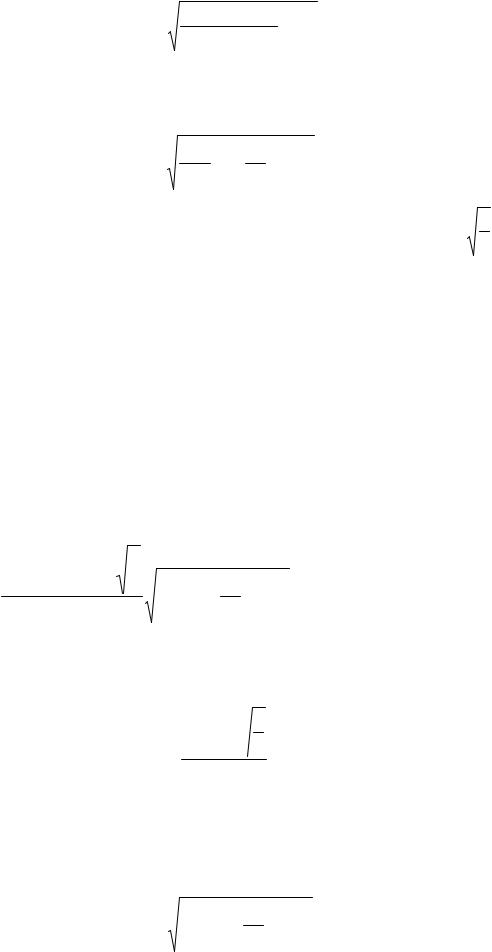
h 2 g (ρ n− ρ in) + w 2 |
||
Bearing in mind that ρ in /ρ n =T n /T in we write the final expression for
w and , m/s: | |||||||||||
W in | |||||||||||
where Тn,Тв – outside temperature | internal air, K; | ||||||||||
air flow coefficient (μ = 0.1 - 0.05).
Let us write down the maximum power of heat loss, kW, by infiltration:
Q иmax = w иρ nF uС in(t in− t n′ ) ,
where Fsh is the area of the cracks in the building, m2; C in is the specific heat capacity of the air,
kJ/(kg K); t in and t n – temperatures of internal and external air, ° C. So, the maximum power, kW, of heat losses by the building:
Q t | Q and | Q t | ||||||||||||||||||
Q t max |
||||||||||||||||||||
ρ nF uС in(t in− t n′ ) | ||||||||||||||||||||
β t V(tв | −t n ′) 10 | − 3 2 gh1 | W in | called coefficient |
||||||||||||||||
infiltration and is denoted by μ.
In the last expression the coefficient
ρ nF uC in ξ q o β t V 10 − 3
called the "infiltration constant", denoted by the letter "in" and measured in s/m.
Let's finally write:
μ = in 2 gh 1 −T n ′ +w in 2 .
Send your good work in the knowledge base is simple. Use the form below
Students, graduate students, young scientists who use the knowledge base in their studies and work will be very grateful to you.
Posted on http://www.allbest.ru/
Introduction
The heat consumption of industrial enterprises makes up a large part of the total heat consumption. Every year the share of centralized heat supply to industrial enterprises from combined heat and power plants is growing, which makes it possible to eliminate a large number of industrial boiler houses and thereby reduce air pollution from emissions of combustion products.
Industrial enterprises receive steam for technological needs and hot water both for technology and for heating and ventilation. Heat networks, steam and water, through which steam and hot water are transported to consumers, are of great importance. The system for returning process steam condensate to thermal power plants is also extremely important. Heat production for industrial enterprises requires large amounts of fuel burned in the furnaces of steam generators in thermal power plants and boiler houses.
For thermal power plants etc. boiler houses, network areas, improving the quality of labor means achieving defect-free work. To do this, it is necessary to carry out a whole system of measures, which include advanced training, personnel training, and a system of preventive repairs.
The efficiency of production is ensured by its high technical and economic indicators, among which the most important are the specific fuel consumption for supplied heat and electricity.
Thermal consumption is the use of thermal energy for a variety of household and industrial purposes (heating, ventilation, air conditioning, showers, baths, laundries, various technological heat-using installations, etc.).
When designing and operating heat supply systems, the following must be taken into account: a) type of coolant (water or steam); b) coolant parameters (temperature and pressure); c) maximum hourly heat consumption; d) change in heat consumption during the day (daily schedule); e) annual heat consumption; f) change in heat consumption during the year (annual schedule); g) the nature of the use of coolant by consumers (direct intake from the heating network or only heat extraction).
Heat consumers make demands on the heat supply system different requirements. Despite this, heat supply must be reliable, economical and qualitatively satisfy all heat consumers.
Heat consumers can be divided into two groups: a) seasonal consumers; b) year-round consumers.
Seasonal consumers do not use heat all year round, but only during some part of it (season), while the heat consumption and its change over time depend mainly on climatic conditions (outside air temperature, solar radiation, wind speed and direction, air humidity). The outside air temperature is of primary importance; The influence of other climatic factors on heat consumption is often neglected.
Seasonal heat consumers are: a) heating; b) ventilation (with air heating in heaters); c) air conditioning (obtaining air of a certain quality, purity, temperature and humidity).
Year-round consumers use heat throughout the year. This group includes: a) technological heat consumers; b) hot water supply to domestic consumers.
If for seasonal consumers, heat consumption practically depends on one factor - the outside air temperature, then for year-round consumers - on many different factors. Thus, technological heat consumption depends on production technology, type of products, type of equipment, operating mode of the enterprise, etc. Climatic conditions have very little effect on heat consumption for year-round consumers.
Year-round consumers ensure the most economical operation of thermal power plants throughout the year, while seasonal load due to its unevenness annual schedule and especially due to the presence of a summer failure, it leads to a decrease in the efficiency of the thermal power plant.
The further development of hot water supply, air conditioning and refrigeration planned in our country will not only further improve living conditions population, but will also have a positive impact on the efficiency of heat supply systems.
1. Schedule of central quality regulation
One of the main ways to regulate heat supply from a centralized heat supply source is to produce heat with optimal, economically most advantageous parameters (qualitative regulation of heat supply). To determine such optimal parameters coolant, a temperature graph is constructed.
The construction of the graph is based on determining the dependence of the temperature of the network water in the supply and return lines on the outside air temperature.
Calculation of coolant temperatures in the supply and return lines of the heating network at different temperatures outside air is carried out according to the formulas:
where t v.r is the estimated indoor air temperature, o C, taken according to Appendix 3
Дt - temperature pressure of the heating device, o C
where f e is the design temperature of the water entering the heating devices (after mixing in the elevator), o C, equal to
where a is the mixing coefficient equal to the ratio of the amount return water, mixed by the elevator to the amount of water coming from the heating network (accepted a = 1...2.5)
Df - calculated temperature difference of water in the heating network at external heating temperature, about C:
Df=f p?f o =140?70=70
and - calculated temperature difference in the local heating system, o C
i=f e -f o =93.33-70=23.33
t n.o - design temperature of the outside air for heating design, o C, determined from table 1.3 for the city of Kazan, t n.o =?29.
t? n - accepted arbitrary values of outdoor air temperatures in the temperature range from t n.o to t v.r., o C
Att? n= t But= ? -29 OWITH
We carry out further calculations in a similar way, specifying the outside air temperatures t? n = -12, -10, -8, …, +8 o C. We summarize the calculation in Table 1.
Table 1 - Construction of the TsKR graph
Based on the data obtained, we build a schedule of central quality regulation.
2. Determination of estimated heat consumption
To determine the estimated heat costs, we will compile a table of characteristics of the buildings that are part of the industrial enterprise for which the heat supply system is being designed.
Table 2 - Characteristics of buildings
|
Designation |
Purpose of the building |
t v.r. , about C |
Specific characteristic, W/(m 3 K) |
Quantity, pcs |
Internal heat dissipation, kW |
Steam consumption, t/h |
||||
|
heating, q about |
ventilation, q in |
washbasins |
||||||||
|
Administrative |
||||||||||
|
Dining room |
||||||||||
|
Mechanical shop |
||||||||||
|
Mechanical shop |
||||||||||
|
Repair shop |
We determine the design heating load Q o, W
Q o =q o V (t v.r?t n.o), (5)
where q o - specific heating characteristic buildings, W/(m 3 K);
V - construction volume of the building according to external measurements, m 3.
t v.r - design air temperature, indoors, o C;
t n.o - outside air temperature for heating design, o C
Q A o. max =0.298 18750 (18+29)=262612.5
Q B o. max =0.45 8000 (16+29)=162000
Q 3 o. max =0.448 37500 (16+29)=756000
Q Z about. max =0.448 37500 (16+29)=756000
Q And about. max =0.38 50000 (18+29)=893000
The main task of heating is to maintain the temperature of the premises at a given level. To do this, it is necessary to maintain a balance between the building’s heat losses and heat gain. Thus, when determining the estimated heat consumption for heating industrial buildings it is necessary to take into account the amount of internal heat generation from the technological equipment of workshops, which are quite stable and often represent a significant share of the design heating load, as well as infiltration losses, reaching 25-30% of heat loss through external fences. Hence,
Q? O. max = m Q o . max - Q int,(6)
where m is the infiltration coefficient; for public buildings m=1, for industrial buildings m=1.25...1.3;
Q int? internal heat generation, W;
Q? And o. max =1 262612.5=262612.5
Q? b o. max =1 162000-90000=72000
Q? Z o. max =1.3 756000=982800
Q? z o. max =1.3 756000=982800
Q? and about. max =1.3 893000=1160900
Q c. max =q in V (t v.r?t n.v), (7)
where q in - specific heat consumption for ventilation, W/(m 3 K);
t n.v? design temperature of outside air for ventilation design, o C; for Kazan according to table 1.3 t n.v. = -18 o C
To reduce the estimated heat consumption for ventilation, the minimum outside temperature used to calculate ventilation units, t n.v is accepted, as a rule, higher than the design temperature for heating t n.o. According to current standards, the estimated outside air temperature for ventilation design is defined as the average temperature of the coldest period, constituting 15% of the duration of the entire heating period. The only exceptions are industrial workshops with a large release of harmful substances, for which t n.v. is assumed to be equal to t n.o (such shops include iron foundry, steel foundry, thermal, forging, copper foundry, metal coating shop)
Q A c. max =0.113 18750 (18+18)=76275
Q b c. max =0.8 8000 (16+18)=217600
Q 3rd century max =0.15 37500 (16+18)=191250
Q z in. max =0.15 37500 (16+18)=191250
Q and v. max =0.1 50000 (18+18)=180000
where 1.2 is a coefficient that takes into account the cooling of hot water in subscriber hot water supply systems;
m - number of showers, pcs;
a - consumption rate of hot water in the shower, a = 60 l/person;
t cm1 - temperature of the hot and cold water in the shower t cm1 = 37 o C;
t cold - cold temperature tap water t x.v =5 o C;
n - number of washbasins, pcs;
b - rate of hot water consumption for the washbasin, b=5 l/h;
t cm2 - temperature of the mixture of hot and cold water in the washbasin t cm2 = 35 o C;
с р - heat capacity of water с р =4.19 kJ/(kg K);
We summarize all calculations of thermal loads in Table 3
Table 3 - Estimated thermal loads of the enterprise
|
Designation |
Purpose of buildings |
||||||
|
Administrative |
|||||||
|
Dining room |
|||||||
|
Mechanical shop |
|||||||
|
Mechanical shop |
|||||||
|
Repair shop |
|||||||
3. Plotting graphs of heat consumption
The heat consumption graph for individual types of heat consumption and the total heat consumption graph are plotted at three points corresponding to three average daily outdoor temperatures: tn, tn.v and tn.o.
It is necessary to take into account that in buildings with internal heat emissions, the beginning of the heating season occurs at a lower temperature t n, o C
To determine the missing heat loads for heating and ventilation, the following formulas for recalculating heat loads are used:
The calculation is carried out separately for each building for outdoor temperatures of +8 o C, +5.2 o C, +4.65 o C, 0 o C, -2 o C, -14 o C, followed by summation by load type.
The calculation results are summarized in Table 4.
Table 4 - Calculation of loads for constructing a heat consumption graph
|
Designation |
Purpose of buildings |
Heat consumption, W |
||||||||
|
Administrative |
||||||||||
|
Dining room |
||||||||||
|
Mechanical shop |
||||||||||
|
Mechanical shop |
||||||||||
|
Repair shop |
||||||||||
|
for all buildings |
||||||||||
The heat load on hot water supply is year-round; during the heating season it is conventionally assumed to be constant, independent of the outside air temperature. Therefore, the graph of heat consumption for hot water supply is a straight line parallel to the abscissa axis.
In the summer (range of standing duration t n from n o to n = 8400 hours) there are no thermal loads on heating and ventilation, the load on hot water supply will be 80% of the winter load on hot water supply
The right part of the graph represents the dependence of the total heat load corresponding to certain average daily outside air temperatures (from the left part of the graph) on the duration of these temperatures (the number of hours during the heating period with average daily outside air temperatures equal to or lower than the data).
To construct the right side of the graph, we determine the duration of the temperature for the city of Kazan
Table 5 - Duration of standing outside air temperatures
Based on the data obtained, we construct an annual graph of heat consumption according to the duration of heat loads.
4. Determination of estimated flow rates of network water
heat network water heating
The estimated costs of network water are determined separately for each type of load.
Estimated consumption of network water for heating G o, kg/s
where f p, f o - temperatures of network water in the supply and return pipelines at temperature t no;
с - heat capacity of water, kJ/(kg K)
Estimated consumption of network water for ventilation G in, kg/s
where is f? p, f? o - temperature of network water in the supply and return pipelines at temperature t n.v (except for buildings V, D, D, E, N, P for which the estimated flow rates of network water are calculated at temperature t n.o), determined from the TsKR vacation schedule warmth
Estimated consumption of network water for hot water supply G gw, kg/s
where is f? p, f? o - temperature of network water in the supply and return pipelines at temperature t n.i.; determined from the TsKR heat supply schedule
We summarize the estimated network water costs for each building in Table 6.
Table 6 - Estimated costs of network water
|
Designation |
Purpose of buildings |
|||||
|
Administrative |
||||||
|
Dining room |
||||||
|
Mechanical shop |
||||||
|
Mechanical shop |
||||||
|
Repair shop |
||||||
To construct graphs of network water consumption, except for calculated ones, i.e. maximum, other characteristic values of network water flow rates are determined using the same formulas.
We present the calculation in Table 7
Table 7 - Consumption of network water depending on the temperature of the outside air
|
Designation |
Purpose of buildings |
Network water consumption, kg/s |
||||||||
|
Administrative |
||||||||||
|
Dining room |
||||||||||
|
Mechanical shop |
||||||||||
|
Mechanical shop |
||||||||||
|
Repair shop |
||||||||||
|
for all buildings |
||||||||||
Based on the results obtained, we construct schedules of network water consumption for each type of load for all buildings, as well as a summary schedule of network water consumption for all types of load
5. Hydraulic calculation of the heating network
The main task of hydraulic calculation is to determine the diameters of pipelines, as well as pressure losses in sections of heating networks. Hydraulic calculation of a closed heat supply system is performed for the supply pipeline, taking the diameter of the return pipeline and the pressure drop in it to be the same as in the supply.
Before performing a hydraulic calculation, a design diagram of heating networks is developed. It shows the section numbers (first along the main line, and then along the branches), coolant flow rates, kg/s, section lengths, m. The main line is the longest and busiest branch of the network from the heat source (connection point) to the most distant consumer.
The calculation consists of two stages: preliminary and verification
5.1 Preliminary calculation
We determine the coefficient that takes into account the share of pressure losses in local resistances b
where G is the coolant flow rate in the area, kg/s.
We preliminarily determine the approximate pressure loss R l, Pa/m
where Dr n is the value of specific friction losses, Pa/m, taken according to the recommendations:
In sections of the main highway 20-40, but not more than 80 Pa/m;
On branches - according to the available pressure drop, but not more than 300 Pa/m
The diameter of the pipeline is determined by the formula
where is the coefficient determined according to Appendix 7; for pipes with equivalent roughness k e =0.0005;
G - coolant flow in the area, kg/s
The data obtained as a result of the calculation is summarized in Table 8
Table 8 - Preliminary hydraulic calculation
|
d standard |
Speed |
||||||||
|
d n Chd st, mm |
|||||||||
Assuming that the density of water is 1000 kg/m3, let’s check the speed of water in the pipeline, which should not exceed 3.5 m/s
5.2 Verification calculation
After establishing the diameters of the heat pipelines, an installation diagram is developed, which consists of placing fixed supports, compensators and shut-off and control valves along the route of the heating networks. In the areas between the nodal chambers, i.e. the chambers in the branch nodes, fixed supports are placed, the distance between which depends on the diameter of the heat pipe, the type of compensator and the method of laying the heat networks. A fixed support is installed in each nodal chamber. A compensator is provided in the area between two fixed supports. Turns of the heating network route at an angle of 90-130° are used for self-compensation of temperature extensions, and in places of turns at an angle of more than 130°, fixed supports are installed. Fixed supports are placed on heating pipes of larger diameter, shut-off valves installed on all branches and on main sections through one or two branches. In the chambers on the branches to individual buildings For branches with a diameter of up to 50 mm and a length of up to 30 m, shut-off valves may not be installed. In this case, fittings must be provided to ensure the disconnection of a group of buildings with a total thermal load of up to 0.6 MW.
Determine the actual linear specific pressure drop R? l, Pa/m:
Where A b R - coefficient determined according to Appendix 7
A b R =13,62 10- 6
Determine the equivalent length of local resistances, m
where is A? - coefficient determined according to Appendix 7
Uo is the sum of the local resistance coefficients installed on the site.
section 1:
Uo=1+1.7+0.5=3.2
section 2:
Tee-passage, valve, U-shape. compensator with smooth bends
Uo=1+1.7+0.5=3.2
section 3:
Tee-passage, valve (2 pcs), two-seam welded bend 90 o,
P-arr. compensator with smooth bends
Uo=1+2 0.5+0.6+1.7=4.3
section 4:
Uo=1.5+2 0.5=2.5
section 5:
Branch tee, valve (2 pcs)
Uo=1.5+2 0.5=2.5
section 6:
Branch tee, valve (2 pcs)
Uo=1.5+2 0.5=2.5
section 7:
Branch tee, valve (2 pcs)
Uo=1.5+2 0.5=2.5
Then we determine the pressure loss in the area, Pa
After determining the pressure loss in each section of the heating network, we calculate the pressures in the supply N p i and return N about i pipelines, as well as the available pressure N p i at the end of each section.
At the end of the first section for the supply line N p1, Pa, is determined by the formula:
N n1 = N n -Dr 1 (22)
where N n is the pressure in the supply line at the connection point
For subsequent sections, the initial pressure is taken to be the final pressure of the section from which the one being calculated comes out.
The pressure at the beginning of the first section for the return line H o1, m.w.c., is determined by the formula:
N o1 = N k + Dr 1 (23)
where Нк is the pressure in the return line at the connection point
For subsequent sections, the final pressure is taken to be the initial pressure of the section from which the one being calculated comes out.
Available pressure in the area Нр, Pa
N r i = N p i + N o i (24)
We summarize the calculation in Table 9
Table 9 - Verification calculation of the heating network
When linking branches, the diameters of the pipeline at each section are selected so that the pressure loss, Dp, on the branches is approximately the same. For this scheme the following conditions must be met
Dr 3 = Dr 6 = Dr 7 (1216.02=1085.01=1125.36)
Dr 4 = Dr 5 = Dr 2-7 (3615.77 = 3483.9 = 3593.7)
The discrepancy between the largest and smallest value of the first equality is:
The discrepancy between the largest and smallest value of the second equality:
Since the difference does not exceed 10%, we believe that the required equalities are satisfied.
6. Construction of a piezometric graph
After performing the hydraulic calculation of water heating networks, they begin to construct a pressure graph for the design main and characteristic branches. The pressure measured from the axis of the heat pipe is called piezometric, and the pressure graph is called a piezometric graph.
The piezometric graph allows you to: determine the pressures in the supply and return pipelines, as well as the available pressure at any point in the heating network; taking into account the terrain, available pressure and height of buildings, select consumer connection schemes; select auto regulators, elevator nozzles, throttling devices for local heat consumption systems; select network and make-up pumps.
Piezometric graphs are plotted for hydrostatic and hydrodynamic modes of the heat supply system. The origin of coordinates is taken to be the lowest elevation of the terrain contours. The terrain along the heating main and the height of the attached buildings are depicted at the accepted scales. They build a line of static pressure, the value of which must be at least 5 m higher than local heat consumption systems, ensuring their protection from “exposure”, and at the same time must be 10 m (or more) less than the maximum operating pressure for local systems .
The maximum operating pressure of local heat consumption systems is: for heating systems with steel heating devices and for air heaters - 80 m; for heating systems with cast iron radiators - 60 m; for independent connection schemes with surface heat exchangers - 100 m.
The hydrostatic head in heat supply systems with water as a coolant must be determined for a supply water temperature of 100 °C.
Then they begin to construct pressure graphs for the hydrodynamic regime. On the ordinate axis, first, the difference between the lowest elevation of the terrain and the elevation of the axis of the heat pipeline in the chamber connecting the industrial enterprise to the main networks is plotted, then the values of the initial and final pressures of the heating network in this chamber (H p and H o). After this, pressure graphs of the supply and return lines of the heating network are constructed based on the data in Table. 9.
Under the piezometric graph, a straightened single-line diagram of the heating main with branches is placed, the numbers and lengths of sections, pipeline diameters, coolant flow rates, and available pressures at nodal points are indicated.
To construct a piezometric graph, the initial, N p, final, N o and available, N p pressure in the areas is converted into m.water.st. according to the formula:
where g is the acceleration of gravity, m/s 2 , g=9.81;
c is the density of water, kg/m3, taken equal to 1000.
Pressure in the supply, h n, m.w.c., and return, h to, m.w.c., pipeline at the connection point
We summarize the translation results in Table 10
|
at the end of class |
at the beginning of school |
||||||
7. Selection of schemes for connecting buildings to the heating network
The choice of schemes for connecting heating systems to the heating network is made based on the piezometric graph.
In this case, building A must be connected according to an independent circuit, since its absolute elevation is higher than the pressure line in the return pipeline. The remaining buildings can be connected to the system using a dependent scheme with an elevator, since the available pressure in the system is more than 15 m.w.c., however, when taking into account modern trends heating supply, the most preferable would be to connect them according to a dependent circuit with pump mixing.
8. Hydraulic calculation of steam pipelines
The task of the hydraulic calculation of steam pipelines is to determine the diameters of pipelines and pressure losses in sections, based on steam flow, available pressure drop (pressure difference at the beginning Pn and end Pk of the steam pipeline), taking into account changes in steam density due to pressure drop and changes in steam temperature due to losses heat into the environment.
For hydraulic calculations, a design and installation diagram of steam pipelines is developed by analogy with heating network diagrams.
The calculation consists of preliminary and verification
8.1 Preliminary calculation
In the preliminary calculation, it is assumed that pressure losses along the length of the steam pipeline occur uniformly. Then the average specific pressure drop R, Pa/m, is found by the formula
where R n, R k - steam pressure at the beginning and at the end of the steam line, Pa;
Y? - length of the steam pipeline (from the connection chamber to the most distant consumer), m;
b av - average coefficient of local pressure loss
For a steam pipeline consisting of sections with different steam flow rates, the following is determined:
where b i , ? i - local pressure loss coefficient and section length
where G is steam consumption in the area under consideration, t/h;
z - coefficient equal to 0.05..0.1 for steam networks; we accept z=0.07
Approximate steam pressure drop in the area, Pa
Steam pressure at the end of the calculated section, Pa
Hydraulic calculation of steam pipelines is carried out according to the average steam density in the calculated area, kg/m 3
where сн, ск - steam density at the beginning and end of the section, determined by the corresponding steam pressure and temperature, kg/m3.
In a preliminary calculation, the temperature drop of superheated steam for every 100 m is assumed to be Df = 2.0...2.5 o C.
Steam temperature at the end of the calculated section, o C
Average steam temperature at the site, o C
Steam line diameter, m
where is the coefficient determined according to Appendix 7; for pipes with equivalent roughness k e =0.0002
The data obtained as a result of the calculation is summarized in table 11
Table 11 - Initial calculation of pressure drop along the steam line
Since there is no indication of the superheating temperature of the steam, we assume that initially the steam is dry, saturated.
Let us determine the diameters of the steam pipelines by presenting the calculation in the form of table 12
Table 12 - Determination of steam pipeline diameters
|
s n, kg/m 3 |
s to, kg/m 3 |
s avg, kg/m 3 |
||||||||
The conditions are satisfied, therefore, the diameters of the steam pipelines in the sections are selected correctly.
8.2 Verification calculation
By analogy with hydraulic calculation heating network, the standard diameter of the steam pipeline is determined and its installation diagram is drawn up.
Local resistances for each section are determined according to the installation diagram:
section 1:
Tee-passage, valve, U-shape. compensator with smooth bends
Uo=1+1.7+0.5=3.2
section 2:
Tee-passage, valve (2 pcs), U-shape. compensator with smooth bends, double-seam welded bend 90 o
Uo=1+1.7+0.5 2+0.6=4.3
section 3:
Branch tee, valve (2 pcs)
Uo=1.5+2 0.5=2.5
section 4:
Branch tee, valve (2 pcs)
Uo=1.5+2 0.5=2.5
Find the actual values of specific pressure loss R? l, Pa/m:
Where A R - coefficient determined by application according to adj. 7; for pipes with equivalent roughness k e =0.0002 A R =10,6 10- 3
Using formulas (20)-(21), we determine the equivalent length of local resistances and the vapor pressure at the end of the design section.
Value A? determined according to Appendix 7 for pipes with equivalent roughness k e =0.0002 A? =76.4.
We present the determination of actual pressure losses for each section in the form of table 13
Table 13 - Determination of actual pressure loss
|
s avg, kg/m 3 |
||||||||||
The actual steam temperature at the end of the calculated section is determined by the formula
where q i - specific losses heat output by an insulated steam pipeline, W/m, are determined according to Appendix 9
c i is the specific heat capacity of steam corresponding to the average steam pressure in the area, kJ/(kg K);
G i - steam consumption at the site, t/h
We present the calculation in the form of table 14
Table 14 - Determination of steam temperature at the end of the section
|
s, kJ/(kg K) |
||||||||
Recalculation is not required, since the recommended speed limit is observed for the selected diameters. When calculating, it was found that condensate may fall out in the final sections (f k i is lower than the steam saturation temperature corresponding to the pressure P k i), therefore it is necessary to install condensate traps along the entire route.
9. Hydraulic calculation of the condensate pipeline
The hydraulic calculation of the condensate pipeline is carried out similarly to the pipelines of water heating networks.
The diameter of the condensate pipeline is determined by the condensate flow rate and the specific pressure drop along the length R l, which should be no more than 100 Pa/m.
First of all, the main design main line is calculated, then the remaining sections are calculated with the obligatory linking of all branches.
9.1 Preliminary calculation of the condensate pipeline
The calculations are carried out according to the formulas given in paragraph 5.1 based on the calculation scheme.
We determine according to Appendix 7; for pipes with equivalent roughness k e =0.0002
The data obtained as a result of the calculation is summarized in table 15
Table 15 - Preliminary calculation of the condensate pipeline
|
d standard |
Speed |
||||||||
|
d n Chd st, mm |
|||||||||
9.2 Verification calculation of the condensate pipeline
The calculation is carried out according to the formulas given in paragraph 5.2
Odds A b R , A? determined according to Appendix 7
A b R =10,92 10- 6
Using the wiring diagram, we determine local resistances for each section:
section 1:
Tee-passage, valve, U-shape. compensator with smooth bends
Uo=1.5+1.7+0.5=3.7
section 2:
Tee-passage, valve (2 pcs.), U-shape. compensator with smooth bends, double-seam welded bend 90 o
Uo=1.5+1.7+0.5 2+0.6=4.8
section 3:
Branch tee, valve (2 pcs)
Uo=2+2 0.5=3.0
section 3:
Branch tee, valve (2 pcs)
Uo=2+2 0.5=3.0
The calculation results are summarized in Table 16
Table 16 - Verification calculation of the condensate pipeline
10. Construction of a longitudinal profile of a heating network
A longitudinal profile is constructed along the route of the heating networks. The longitudinal profile shows: ground surface marks (design - solid line, existing - dashed); intersectable network engineering and structures; marks of the bottom of the heating network pipe, the bottom and ceiling of the channel; depth of the heat pipe; slope and length of heating network sections; heat pipe diameter and channel type; In addition, a detailed plan of the route is given, indicating turning angles, branches, fixed supports, compensators and thermal chambers. With the above-ground installation method, marks are given for the top of the supporting structure and the bottom of the heat pipe.
The slope of the heat pipeline, regardless of the installation method, must be at least 0.002. The number of connections between sections with reverse slopes should be as small as possible.
At the lowest points of the heat pipeline, drainage outlets are provided, and at the highest points, air vents are installed, which are placed in chambers.
According to TKP 45-4.02-182-2009 (02250) Heating network the depth of heating networks from the surface of the earth to the top of the channel ceiling must be at least 0.5 m, to the top of the chamber ceiling - at least 0.3 m, to the top of the heat pipe shell for ductless installation - at least 0.7 m. The height of the overhead installation of heat pipes from the surface of the earth to the bottom of the insulating structure must be at least 0.5 m; in some cases, this distance may be reduced to 0.35 m.
11. Thermal calculation
The problem of thermal calculation in course work is to determine the thickness of the thermal insulation layer using the formula:
where d is the outer diameter of the pipeline, m;
l and - thermal conductivity coefficient of the heat-insulating layer, W/(m o C);
R and - thermal resistance of the insulation layer, (m o C)/W;
According to the initial data for the heating network:
thermal insulation - bitumen perlite (l = 0.12 W/(m o C))
heating network laying - ductless
Thermal resistance of the insulation layer:
where R sum is the total thermal resistance of the insulation layer and other additional thermal resistances along the path of the heat flow, (m o C)/W
where t w is the average coolant temperature over the period of operation, o C
for the supply line - 90
for return line - 70
t e - average annual ambient temperature, o C; for channelless installation - average annual soil temperature; for Kazan t gr =+1 o C;
q e - standard linear heat flux density, W/m
The second component depends on the method of laying the heating network.
For underground channel installation:
R ps - thermal resistance of the surface of the insulating layer, m °C/W, determined by the formula:
b e - coefficient of heat transfer from the surface of thermal insulation into the surrounding air, W/(m 2 °C), which is assumed when laying in channels b e = 8 W/(m 2 °C).
Thermal resistance of the channel surface (R p.k), m °C/W, is determined:
d w.e. - internal equivalent diameter of the channel, m
Thermal resistance of the channel wall (R k), m °C/W, is determined:
l st - thermal conductivity of the channel wall, for reinforced concrete l st = 2.04 W/(m 2 °C);
d AD - external equivalent diameter of the channel, determined by the external dimensions of the channel, m.
The calculation is carried out for each pipeline separately
Soil resistance:
where gr is the coefficient of thermal conductivity of the soil, we accept according to
2.5 W/(m o C)
h - depth of the heat pipe axis, h=1m
d ne is the outer equivalent diameter, we assume that it is conditionally equal to the diameter of the heat pipe together with the maximum insulation thickness for the given conditions.
Additional thermal resistance, taking into account the mutual influence of pipes during channelless installation:
For supply pipe:
For return line:
where b is the distance between the axes of the pipelines, m; accepted depending on their nominal diameters according to Table 11.1
First, let's calculate the total thermal resistance of the insulation layer and other additional thermal resistances along the path of the heat flow. We present the calculation in the form of table 17
Table 17 Total thermal resistance of the insulation layer
|
d n Chd st, mm |
|||||||
Let's calculate the value of the second component and the total resistance of thermal insulation; we present the calculation in the form of table 18.
Table 18. Calculation of the total resistance of thermal insulation
Now let's calculate the thickness of thermal insulation and select standard values. We present the calculation in the form of table 19
Table 19. Calculation of the thickness of thermal insulation.
Since the assignment for the course work does not contain instructions regarding the laying of steam and condensate networks, we accept for calculation the most common method for laying process steam pipelines for enterprises - above-ground laying.
Calculation of the thickness of the insulation layer using formula (37)
t w - average coolant temperature over the operating period
t e - average annual ambient temperature, C, for aerial installation of networks we take the average ambient temperature over the period of operation: t e = 4.1 o C
When laying the route by air we get:
where b o is the heat transfer coefficient from the surface of thermal insulation into the surrounding air, we take it equal to b o = 26 W/(m o C)
d - outer diameter of the pipeline, m
For isolation we take mineral wool with thermal conductivity 0.08 W/(m o C). We present the determination of the thickness of thermal insulation for a steam pipeline in the form of Table 20.
Table 20. Determination of the thickness of thermal insulation for a steam pipeline
Determination of the thickness of thermal insulation for a condensate pipeline is presented in the form of table 21
Table 21. Determination of the thickness of thermal insulation for a condensate pipeline
Literature
1. Sources and heat supply systems for industrial enterprises: method. instructions for course work and practical work. classes one at a time. discipline for students of specialties 1-43 01 05 "Industrial Thermal Power Engineering" and 1-43 01 07 " Technical operation energy equipment of organizations" full-time and part-time forms of education / I.R. Pogartsev, T.S. Yufanova, E.M. Zvezdkina. - Gomel: GGTU named after P.O. Sukhoi, 2008.-39p.
2. Designer's Handbook. Design of thermal networks / ed. A.A. Nikolaev. - Moscow: Stroyizdat, 1965. - 360 p.
3. Sokolov E.Ya. District heating and heating networks: textbook. for universities / E.Ya. Sokolov. - 7th ed. - Moscow: MPEI Publishing House, 2001. - 472 p.
4. V.I. Manyuk, Ya.I. Kaplinsky, E.B Khizh, A.I. Manyuk, V.K. Ilyin Setup and operation of water heating networks / Directory. 3rd ed. - Stroyizdat, Moscow, 1988
5. TKP 45.4.02-182-2009 (02250) Heating networks/ Ministry of Architecture and Construction of the Republic of Belarus Minsk 2010
Posted on Allbest.ru
Similar documents
Estimated heat loads of the area. Selecting a heat release control system. Construction of a schedule for heat release. Determination of estimated flow rates of network water. Selection of compensators and calculation of thermal insulation. Selection of network and make-up pumps.
course work, added 12/10/2010
Construction of schedules for regulating heat supply. Determination of network water consumption by analytical method. Pressure loss in a home heating system. Hydraulic calculation of heating network pipelines. Selection of make-up and network pump.
course work, added 05/14/2015
Outdoor air parameters. Calculation of heat consumer loads. Selecting a heating system. Determination of network water consumption. Construction of a piezometric graph. Temperature chart regulation of a closed independent heat supply system.
course work, added 05/23/2014
Methods for calculating heat consumption for hot water supply. Process heat consumption indicators. Determination of heat consumption for heating and ventilation of buildings. Construction of an annual graph of the heat load of a road transport enterprise.
course work, added 02/09/2011
Characteristics of heat supply facilities. Calculation of heat flows for heating, ventilation and hot water supply. Plotting a graph of heat consumption. Determination of estimated coolant flow rates in the heating network. Calculation of the heating network main line.
course work, added 08/14/2012
Estimation of calculated heat loads, construction of heat consumption graphs. Central regulation of heat supply and heating load. Development of a master plan for the heating network. Selection of pumping equipment for a heat supply system.
course work, added 10/13/2012
Determination of heat consumption for heating and hot water supply. Construction of an annual heat load graph. Drawing up a heating network diagram. Hydraulic calculation of water heating network. Selection of heating equipment and heat supply source.
course work, added 04/11/2015
Determination of annual and hourly heat consumption for heating and hot water supply. Determination of losses in external heating networks, cogeneration. Schedule of central quality heat control. Selection and calculation of heat exchangers, boilers and pumps.
thesis, added 06/21/2014
Industrial and technological consumers of steam and hot water. Heat supply via network water. Selection of steam turbines. Estimated, annual and average heat loads. Plotting a graph of load by duration. Selection of the main equipment of a thermal power plant.
course work, added 06/09/2015
Determination of the estimated thermal loads of the city area. Plotting graphs of heat consumption. Regulation of heat release. Estimated costs coolant in heating networks. Hydraulic and mechanical calculation of water heating networks, selection of pumps.
Federal Agency for Education East Siberian State Technological University ENTERPRISE HEAT SUPPLY SYSTEM Guidelines for the heat engineering part of the final qualifying work for students of technological specialties of the Institute of Food Engineering and Biotechnology of VSTU. Compiled by: Batuev B.B. Mathanova V.E. Reviewer Ts.Ts.Dambiev, Doctor of Technical Sciences, Signed for publication on June 21, 2005. Format 60x84 1/16. Professor Usl.p.l. 1.16, educational sheet. 0.8. Circulation 100 copies. Order No. Publishing house VSGTU. Ulan-Ude, st. Klyuchevskaya, 40, b. Ulan-Ude © VSGTU, 2005 Publishing house VSGTU 2005 Methodological instructions “Heat supply system of an enterprise” for the heat engineering part of the final qualifying work are intended for graduate students of technological specialties of the Institute of Food Engineering and Biotechnology. They set out the requirements for heat supply systems of enterprises, provide basic heat supply schemes and discuss the economic feasibility of each of them. The guidelines provide the procedure for thermal engineering calculations in cases of designing a new enterprise and reconstructing an existing enterprise. Recommendations are given on the choice of heat supply scheme for the enterprise, selection of the type of fuel and main equipment of the boiler room, as well as on rational use secondary energy resources. Key words: Heat supply of an enterprise, thermal engineering calculation, heat capacity, enthalpy, heat load, apparatus performance, heating, ventilation, hot water supply, technological needs, heat sources, heat consumption schedules, steam consumption, hot water consumption, steam pipeline, boiler unit, secondary energy resources. INTRODUCTION Indispensable conditions for rational heat supply Thermal engineering section of graduate enterprises - the possibility of using local types of qualifying work (VKR) students of fuel, a reasonable choice of reserve fuel and technological specialties of the Institute of Food, the effective use of secondary energy engineering and biotechnology is developed for the purpose of resources. calculation of the heat supply system of the designed Heat supply for food enterprises. industry should provide for the presence of a reserve The topic of final qualifying works of heat, which is explained by uneven receipt, provides for two types of graduation projects: raw materials due to the seasonality of production. When choosing 1. Design of a new enterprise; heat supply schemes should include 2. Reconstruction of an existing enterprise. the possibility of long-term development of the thermal economy When designing a new enterprise by reconstructing the enterprise and increasing its thermal engineering part, graduate student production capacity. independently decides the issue of choosing a scheme. In this case, it is necessary to use the possibilities of heat supply to the enterprise on the basis of calculated combined heat supply, providing for the release of total heat loads. coolants to other enterprises, as well as obtaining cheaper heat of low potential during the reconstruction of an existing enterprise. In the thermal engineering part of the VKR, it is developed in order to save fuel by quickly checking the throughput of the system, putting into operation or stopping individual heat supplies due to changes in heat loads. heat generating devices in case of sharp fluctuations in the raw material receipt schedule. At the same time, to cover 1. REQUIREMENTS FOR HEAT SUPPLY heat loads in the thermal scheme, it is advisable for the ENTERPRISE to provide for heat accumulation. Organization Rational organization of heat supply - heat supply should provide the most important condition for the economical operation of enterprises, the rational operation of all elements of the scheme guaranteeing the production of high quality products. heating supply, guaranteeing the receipt of One of the main requirements for coolants of the required parameters and high heat supply of enterprises is right choice quality schemes. heating supply, complete with equipment. For this purpose, devices must be provided that are commercially produced by industry. The scheme allowing for automatic regulation of heat supply must provide for reliable parameters of coolants and their distribution for uninterrupted supply of steam and hot water to consumers. Application of automatic regulation of required parameters by water. Moreover, it ensures safe operating conditions for the equipment and creates favorable boiler rooms equipped with boilers of medium and small working conditions for operating personnel. productivity. Rational heat supply to enterprises should This is due both to the lack of centralized ones to create conditions for the widespread use of secondary heat supply sources in geographical areas of energy resources. Wherein Special attention There should be a placement of enterprises in the industry, and increased attention should be paid to increasing the return of condensate and organizing the requirements for the quality of consumed coolants. recycling water supply. The specific nature of food industry enterprises The reliability of heat supply to an enterprise should place special demands on them sanitary requirements, in connection with being provided with both the ease of servicing all such enterprises, as a rule, are located outside the elements of the thermal economy, and the possibility of them being located outside the city limits. quick repairs with minimal labor costs. Economically feasible supply radius The heat supply scheme of the enterprise should include coolants from the thermal power plant (steam - up to 3 km, hot water - up to compact, providing minimal losses heat and 10 km) limits the possibility of centralized leakage of coolants during their production and heat supply to enterprises. Due to the fact that at the thermal power plant from transportation. other non-food enterprises (chemical and other One of the main requirements for plants) can return condensate containing heat supply - its efficiency, as well as the reduction of toxic substances, eliminating the possibility of environmental pollution. use in live steam industry enterprises. The efficiency of heat supply is determined. With centralized heat supply, it is not always the minimum possible capital costs and it is possible to provide enterprises with steam at the operating costs and specific costs of the required parameters and in sufficient quantities. In addition, heat and fuel for production. However, the thermal power plant places increased demands on the quality and quantity of the returned condensate, which 2. HEAT SUPPLY SCHEME enterprises in the industry cannot always meet. ENTERPRISES. Heat supply scheme for the enterprise from its own 2.1. Heat supply to enterprises from their own boiler houses is presented in /4/ in Fig. 1, p.11. boiler rooms Despite the fact that the main focus is 2.2. District heating is an efficient fuel use enterprise. centralized heat supply based on thermal power plants. Currently, with the help of centralized heat supply, the overwhelming majority of food heat supply enterprises satisfy the need for industrial heat; they are supplied with heat from their own small number of enterprises in the industry. The reasons why the vast majority of food industry enterprises have their own sources for the construction of the enterprise and accelerate the timing of its commissioning of heat supply were mentioned earlier. exploitation. At the same time, the number of personnel is reduced. Note, however, that when using service personnel. The absence of its own centralized heating supply significantly reduces the size of the territory, increases the efficiency of heat production, as well as the space occupied by the enterprise, and reduces consumption; the specific fuel consumption for its production decreases. electricity. In addition, maneuverability in the use of various types of fuel increases, the content of harmful emissions from thermal power plants into the environment is reduced and the sanitary condition of the air basin is improved. Towards centralized heat supply sources 2.3. Combined heat supply includes combined heat and power plants (CHP), as well as industrial boiler houses that provide heat Distinctive feature a combined group of food enterprises and those located either on heat supply means that the enterprise is supplied with an independent balance, or is part of one ferry for technological needs from its own enterprises. boiler room, and for the needs of hot water supply and heating. With an increase in the degree of centralization, district heating water obtained from thermal power plants is used. heat supply, as a rule, increases efficiency. This organization of heat supply to heat production enterprises and reduces the costs associated with it is primarily due to stringent requirements for the operation of heat supply sources. At the same time, the purity of live steam used in mixing plants increases the initial costs of maintaining heat exchangers for direct heat transfer and operating costs for the impact on the product being processed. transportation of heat to consumers. This, in addition, is also explained significantly. It should be borne in mind that if centralization with a smaller economically feasible radius of heat supply on the basis of group boiler houses is always transporting steam in comparison with heating, it is economically feasible for several enterprises, water. The efficiency of combined heat supply and the feasibility of district heating is achieved only by the lower cost of hot heat with a high degree of concentration and large amounts of water received from the thermal power plant. thermal loads that allow the construction of a combined heat and power plant. Scheme of combined heat supply of increased power. enterprise is presented in /4/ in Fig. 3, p. 17. The advantage of centralized heat supply is that the absence of a boiler room and fuel economy significantly reduces capital costs by 3. DESIGNING A NEW parameters (pressure, temperature) of the ENTERPRISE coolant (steam or hot water) from the technical data sheet of the equipment and determine the maximum Thermal engineering calculation must begin with pressure Pmax . choosing a heat supply scheme: from your own boiler house, 3. Determine heat loads. centralized heat supply from CHP or Total heat load of the enterprise combined heat supply. Depending on the determined by the formula: the selected heat supply scheme of the enterprise, the goals of the thermal engineering calculation are formulated. Q = Q0 + Qv + Qg.v.+ Qt, (1) For the case of heat supply to an enterprise from its own boiler house, the graduate student needs to calculate where Q0, Qv, Qg.v., Qt, are the heat loads on the total heat loads of the enterprise and on their basis heating, ventilation, hot water supply, select the basic (type and performance of boilers) and technological needs, respectively. auxiliary equipment, then install the most Thermal loads for heating, ventilation and the type of fuel that is appropriate, taking into account local resources, hot water supply is calculated according to the aggregated indicators /1, chapter II, pp. 34 – 51/. it and, based on hydraulic calculations, determine the diameters of pipelines for steam and hot water. Thermal load for heating. For the case of centralized heat supply from a thermal power plant, the total heat loads of the enterprise are also calculated, then the consumption of steam or Q0 = q0 V (tв - tн), (2) hot water for each type of heat consumption (heating, ventilation, hot water supply, where q0 is the specific heat loss) is determined buildings representing technological needs) and hydraulic calculation of heat loss by heat transfer through the diameters of pipelines for steam and hot external fences are determined with the difference between internal and water. external temperature 1 degree, referred to 1 m3 Thermal engineering calculation is carried out in the following external volume of the building, [W/m3 K]; sequences: V – volume of the building according to external measurements, [m3]; 1. Select the heat supply scheme of the enterprise and tв – internal temperature in the room; give it short description. tn – external air temperature, determined by 2. Characterize the technological climatological data, equipment consuming thermal energy . The design temperature of the outside air for the initial heating design for each device is assumed to be equal to the average of the coldest five days of the eight coldest tх - cold water temperature. It is taken in cold winters over 50 years. heating period tx = 50C, in summer tx = 150C; Heat load on ventilation nc – estimated duration of heat supply to hot water supply, [s/day]. Qв = qв V (tв - tн), (3) where qв is the specific heat consumption for ventilation, that is, Thermal load for technological needs is the heat consumption per 1 m3 of a ventilated building according to the external measurement and per 1 degree of difference Thermal load on technological equipment between the air temperature inside is defined as the sum of the heat loads on each ventilated premises (tv) and heat-consuming apparatus of the enterprise, taking into account the outside air temperature (tn), [W/m3]; equipment operation per day according to its schedule V – volume of buildings according to external measurements, [m3]. work: The design temperature of the outside air for n designing ventilation is determined as the average QT = ∑Q, i =1 i (5) the temperature of the coldest period, which is where Qi is the heat load for each 15% of the duration of the entire heating season. heat-consuming apparatus of the enterprise. The values of the design temperatures of the outside air for the design of heating and ventilation are given in Qi = GT Cpm (tend – tstart), (6) /1/, Appendix 1. where GT is the performance of the device (according to the passport data); [kg/s]; Thermal load on hot water supply Cpm – heat capacity of raw materials, [kJ/kg K]; tfin – final temperature of the raw material; αmC pm (t g − t x) tinit – initial temperature of the raw material. Qg.v. = , (4) nc where α is the rate of consumption of hot water with temperature 3.4. Determination of steam consumption tg = 650C, /1/, Appendix IV; The total steam consumption at the enterprise is determined by m - the number of units of measurement; equation: Cpm - heat capacity of water; tg – temperature of hot water supplied to the system D = D0 + Dv + Dg.v + Dt, (7) hot water supply; tg = 650C; where D0, Dv, Dg.v, Dt – steam consumption for heating, ventilation, hot water supply, technological needs, Table 2, respectively. No. Type of load Thermal Steam consumption, Steam consumption for a separate type of heat consumption load, kW kg/s is calculated by the formula: 1. 2. Q 3. Д= , (8) η (h′′ − h′) 4. where Q – heat load for heating, ventilation, 5. hot water supply or technological needs; Total: η - heat utilization coefficient To the found total steam consumption of the enterprise (taken from table. 1); it is necessary to add another 10% for unforeseen h", h" - the enthalpy of dry saturated steam and costs and losses. boiling liquid at maximum pressure Pmax (determined from tables /3/). 3.5. Selection of equipment for the boiler room Calculation data is entered into Table 2. Based on the total steam consumption, enterprises select the equipment necessary for the boiler room /2, Chapter IV, page. Values of heat utilization coefficients at 76-95/. separate type of consumption The number of boilers is selected based on the provision of Table 1 power changes (maximum 50%) in the event of an emergency Type of load η Water temperature, 0C state. t initial t final The boiler characteristics must indicate the boiler type Heating 0.95 150 70, productivity, production pressure and steam temperature, dimensions of the boiler and lining, as well as Ventilation 0.9 120 60 efficiency. boiler and furnace. Hot 0.92 70 5 water supplied 3.6. Selecting the type of fuel and determining its hourly consumption Technological 0.95÷0.98 Taking into account the type of boiler and local resources, select the type of fuel from the nearest deposit and give its full equipment characteristics /2, chapter IV, pp. 76-95/. e Hourly fuel consumption is determined by the equation: Heat loads and steam consumption D (hp - hp.v) + D pr (hk.v - hp.v) Rl – specific linear pressure drop per unit B = , (9) pipeline length, [Pa/m]; η Qнр ρср – average coolant density in the area, [kg/m3]. where D is the steam output of the boiler; hп, hк.в – enthalpy of steam and boiler water at pressure in Specific linear pressure drop per unit boiler /3/; pipeline lengths are found using the formula: hp.v. – enthalpy of feed water (hp.w = Av ⋅tp.w; Av = 4.19 kJ/kg K; tp.w. – indicated in the ∆P characteristic of the boiler); Rl = , [Pa/m] (11) λ(1 + α) Dp.r - the amount of steam lost when blowing the boiler (take 3% of the boiler steam output); where ∆Р – pressure drop in the pipeline, [Pa]; ηk.a. – efficiency boiler unit; ℓ - distance from the boiler room to the workshop, [m]; p α - share of local losses, determined by the formula Q n - lower heating value of fuel. Shifrinson: α=Z D, (12) 3.7. Determination of system capacity where D is the total flow of water vapor at the enterprise, [kg/s]; and the choice of the diameter of the steam pipeline Z is a constant coefficient depending on the type of hydraulic calculation, the main task of which is the coolant. is to determine the diameters of pipelines, their For water Z = 0.03 ÷ 0.05. throughput and regulation of the system is one of the most important sections of design and operation. For water vapor Z = 0.2 ÷ 0.4. heating network. The average density of the coolant in the area The method for calculating the diameters of pipelines and theirs is found by the formula: throughput capacity is set out in /1, chapter V, page 136- ρ + ρ end ρ av = beginning, (13) 167/. 2 The diameter of the pipeline for water vapor is determined. The indices “start” and “end” refer to the beginning and end according to the formula: the pipeline section. Densities ρstart and ρend are determined from tables /3/. D 0.38 If the coolant is liquid, then take: d = Ad, [m] (10) (R ρ) l av 0.19 ρav = ρstart = ρend Based on the calculated diameter of the pipeline, select (14) where D is the total flow rate of water vapor at the enterprise, [kg/s] standard diameter of pipes used in transport Ad – coefficient equal to 0.435 m0.0475; water vapor and water /1, appendix 11, p.334/. 3.8. Proposals for the use of secondary energy resources The throughput capacity of the heat supply system is determined in the following sequence. The energy of waste coolants (gases, vapors and 1. Characteristics of the existing liquid system), as well as waste and finished heat supply products of a production plant, represents secondary A) draw up a diagram of a boiler room or heating point energy resources (ER). (indicate the types of boilers, their productivity, pressure and steam temperature in food industry enterprises, etc.); the largest reserve of secondary energy resources B) draw up a heat supply diagram for the plant or exhaust flue gases from boiler installations of the reconstructed workshop and give a description (18.6%), ventilation emissions (18%), waste heat from thermal energy consumers indicating (15.8%) and hot water (13.8%), secondary vapor of evaporation coolants (steam or hot water); and drying plants (9.8%), finished products(8.4%). C) describe the system for using secondary energy resources. The waste gases of energy resources at the enterprise have smaller reserves of energy resources. technological equipment (7.3%), steam-condensate 2. Determination of thermal loads mixture (5.7%), as well as exhaust flue gases Heat loads before and after reconstruction of technological furnaces (2.5%). are determined in the same way as when designing a new one. Based on an energy analysis of the enterprise’s operation (see section 3, paragraph 3). technological equipment, the graduate needs 3. Determine the throughput of the system and develop proposals for the rational use of the choice of pipeline diameters. VERov /2, chapter VIII, pp. 145-163/. Hydraulic calculations are carried out in the same way as when designing a new enterprise (see section 3, paragraph 4. RECONSTRUCTION OF AN EXISTING 3.7). ENTERPRISES 4. Proposals for the use of secondary thermal energy resources during the reconstruction of an enterprise (see section 3, paragraph 3.8). part of the thesis project is being developed to test the throughput of the heat supply system in connection with changes in heat loads. 1. Sokolov E.Ya. District heating and heating networks. -M.: If the thermal loads after the reconstruction of Energoizdat, 1982. increased and the throughput of the system did not 2. Lepilkin A.N., Nozdrin S.I., Tertychny A.M. satisfies them, then the graduate needs to replace heat supply for meat and dairy enterprises with pipelines for steam and hot water on an industrial basis. -M.: Food industry, 1976. hydraulic calculation.
(Document)
n1.doc
Ministry of General Education of the Russian Federation
South Ural State University
Department of Industrial Thermal Power Engineering
LECTURE NOTES
BY DISCIPLINE
"SOURCES AND HEAT SUPPLY SYSTEMS FOR INDUSTRIAL ENTERPRISES"
INTRODUCTION
There are two types of heat supply - centralized and decentralized. With decentralized heat supply, the heat source and heat consumer are close to each other. There is no heating network. Decentralized heat supply is divided into local (heat supply from a local boiler house) and individual (stove, heat supply from boilers in apartments).
Depending on the degree of centralization, district heating systems (DH) can be divided into four groups:
group heat supply (HS) of a group of buildings;
district– urban area vehicle;
urban– city vehicle;
intercity– Vehicles of several cities.
HP preparation is carried out at heat treatment plants of thermal power plants and boiler houses. HP transport is carried out via heating networks. The use of HP is carried out at heat-using installations of consumers.
A set of installations designed for the preparation, transport and use of coolant is called a centralized heating system.
There are two main categories of heat consumption.
For creating comfortable conditions labor and life (municipal load).
2. To produce products of a given quality (technological load).
According to temperature level, heat is divided into:
Low potential, with temperatures up to 150 0 C;
Medium potential, with temperatures from 150 0 C to 400 0 C;
High potential, with a temperature above 400 0 C.
Utility load refers to low-potential processes.
The maximum temperature in heating networks does not exceed 150 0 C (in the forward pipeline), the minimum – 70 0 C (in the return pipeline).
To cover the technological load, water steam with a pressure of up to 1.4 MPa is usually used.
Heat treatment plants of thermal power plants and boiler houses are used as heat sources. The combined heat and power plant produces combined heat and electricity based on the heating cycle. Separate production of heat and electricity is carried out in boiler houses and condensing power plants. With combined generation, the total fuel consumption is lower than with separate generation.
1. CALCULATION OF HEAT CONSUMPTION
Heat load can be divided into seasonal and year-round. Changes in seasonal load depend mainly on climatic conditions - outside air temperature, humidity, wind speed, solar radiation, etc. The main role is played by changes in outside air temperature. Seasonal load has a relatively constant daily schedule and a variable annual one. Seasonal loads include heating, ventilation (winter loads), and air conditioning (summer loads). The year-round load includes the hot water supply (DHW) load and the process load. The technological load schedule depends on the nature of production. The DHW load schedule depends on the improvement of buildings, the composition of the population, the working day schedule, and the operating hours of utility companies. The technological and load of hot water supply weakly depend on the time of year.
1.1. Seasonal load.
The purpose of heating is to maintain the temperature of the internal air in a room at a given level. The air temperature in the room depends on the purpose of the room, and in industrial buildings on the nature of the work performed. The indoor air temperature values are taken in accordance with. In particular,
For residential buildings - from 18 to 20 0 C;
For industrial buildings - from 16 to 20 0 C;
For public buildings - from 14 to 25 0 C.
Calculation of heat supply for heating.
To maintain a constant indoor air temperature, it is necessary to ensure equality of heat loss and heat gain. Heat losses are caused by heat transfer through fences, where the temperature difference is more than 5 0 C - Q t, as well as infiltration, Q inf - heat consumption for heating air coming from the outside through leaks in the fences.
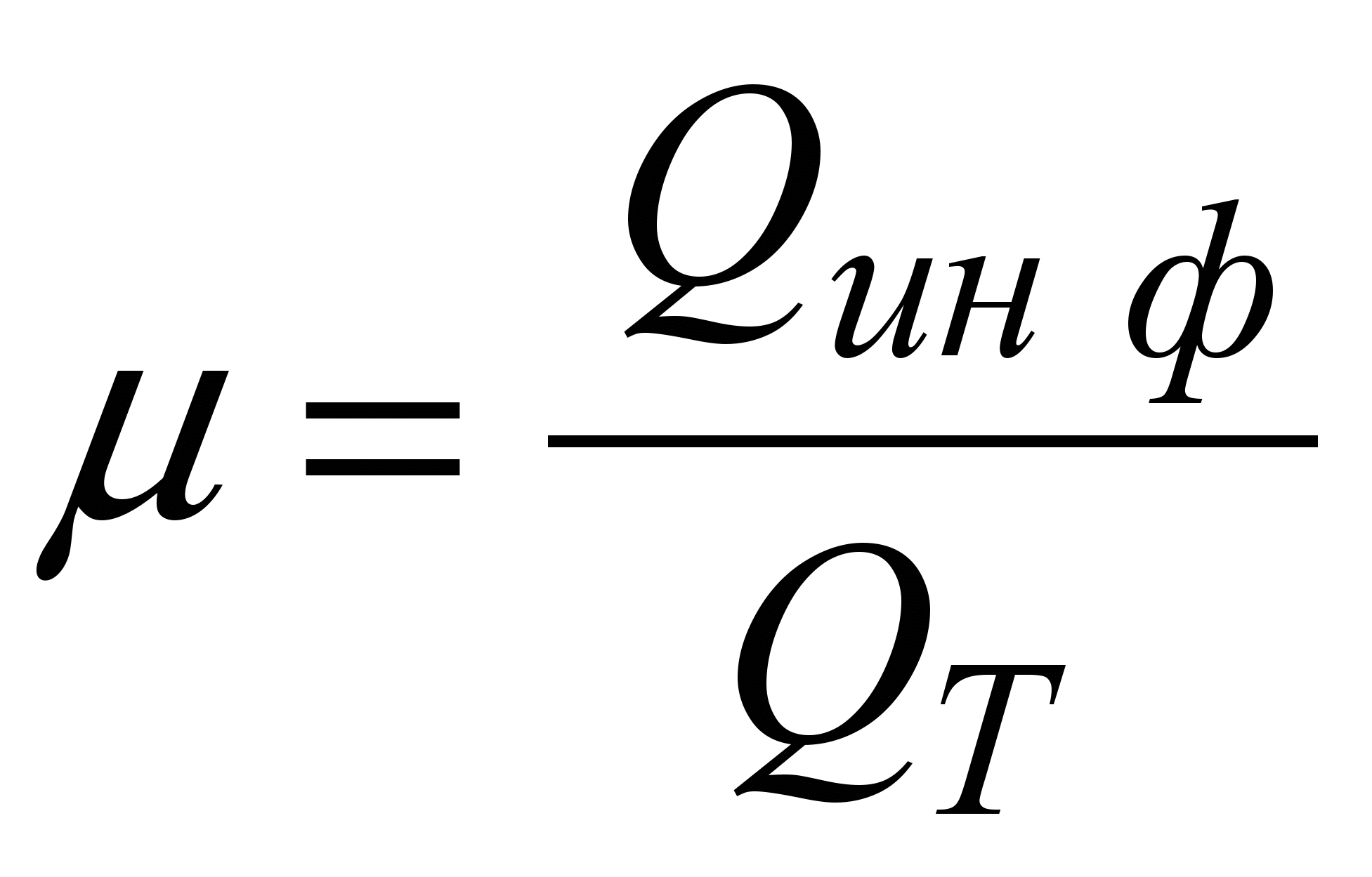 - infiltration coefficient.
- infiltration coefficient.
In industrial premises, heat is also spent on heating materials and Vehicle, coming from outside - Q mt.
Heat flow into the premises is carried out through heating installations - Q o and from internal heat release - Q w.
IN general case The heat balance can be written as
For residential and public buildings:
Q mt = Q inf = Q w = 0, then Q o = Q t.
For production premises:
Q o = Q t (1 +  ) + Q mt - Q w
) + Q mt - Q w
 in industrial premises can be 25...35% of Q o
in industrial premises can be 25...35% of Q o
Here: b– constant infiltration, b=(35…40) 10 -2 ;

g- acceleration of gravity;
L- the height of the opening into which air enters;
T n- outside air temperature, K;
T V- room air temperature, K;
W- wind speed, m/s.
Heat loss by heat transfer is calculated using the equation
 , or
, or
 , (1.1)
, (1.1)
n- correction for temperature difference. Taken into account for the floor of the 1st floor and the ceiling of the upper (n  1);
1);
 - coefficient that takes into account additives for orientation relative to the cardinal directions, number of storeys of the building, wind speed, placement of premises in the building. Provided in SNiP.
- coefficient that takes into account additives for orientation relative to the cardinal directions, number of storeys of the building, wind speed, placement of premises in the building. Provided in SNiP.
Where  - correction taking into account orientation to the cardinal points.
- correction taking into account orientation to the cardinal points.
Formula (1.1) is used when designing heating systems for a particular building, that is, based on the calculation results, the number of heating devices installed in the premises is determined.
When designing heat sources, the heat demand for heating can be determined using aggregated indicators.
1.1.1.1. Determination of heat consumption for heating by building volume.
![]()
Where:
q O- heating characteristics of the building, depending on the volume and purpose of the building. Given in SNiP, as well as in. ; V- volume of the building according to external measurements.
The maximum heat loss and, accordingly, the maximum heat supply for heating is determined by the design temperature for heating - t But . This is the average temperature of the coldest five-day period out of eight winters over the past 50 years.
When calculating using aggregated indicators in the absence of a list of buildings indicating their purpose, t in is taken equal to 18 0 C, if t but  -31 0 C and equal to 20 0 C, if
-31 0 C and equal to 20 0 C, if
t but -31 0 C.
For residential and public buildings, the estimated amount of heat for heating is determined by the formula
 .
.
At 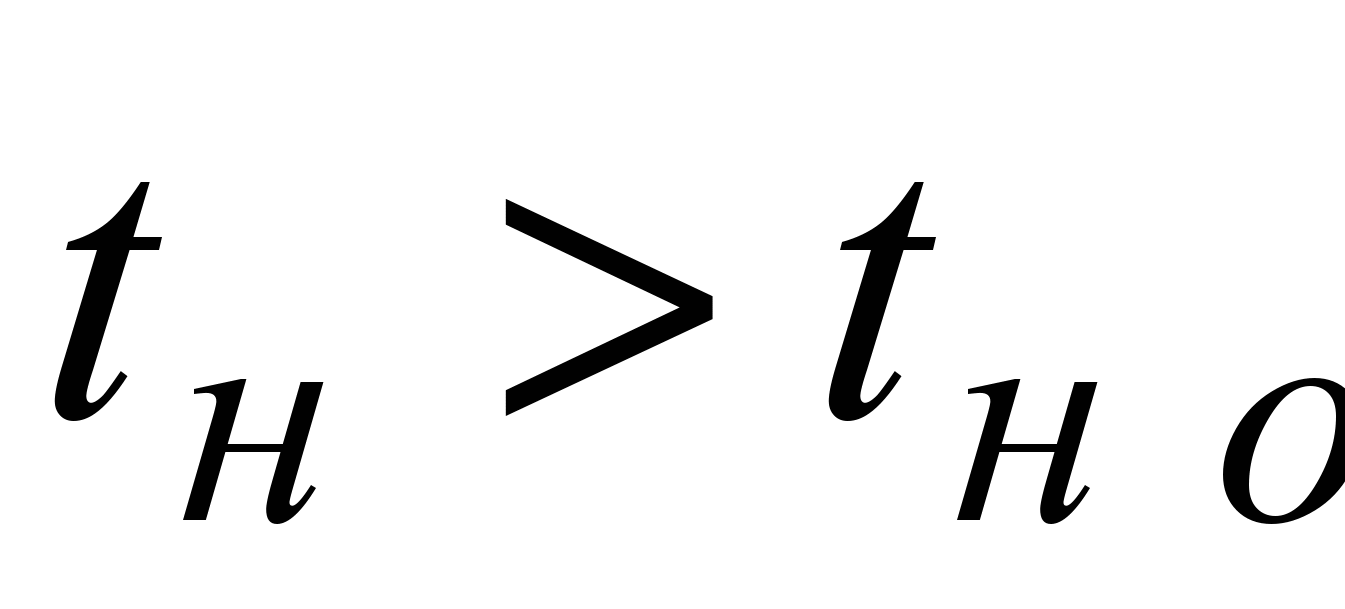
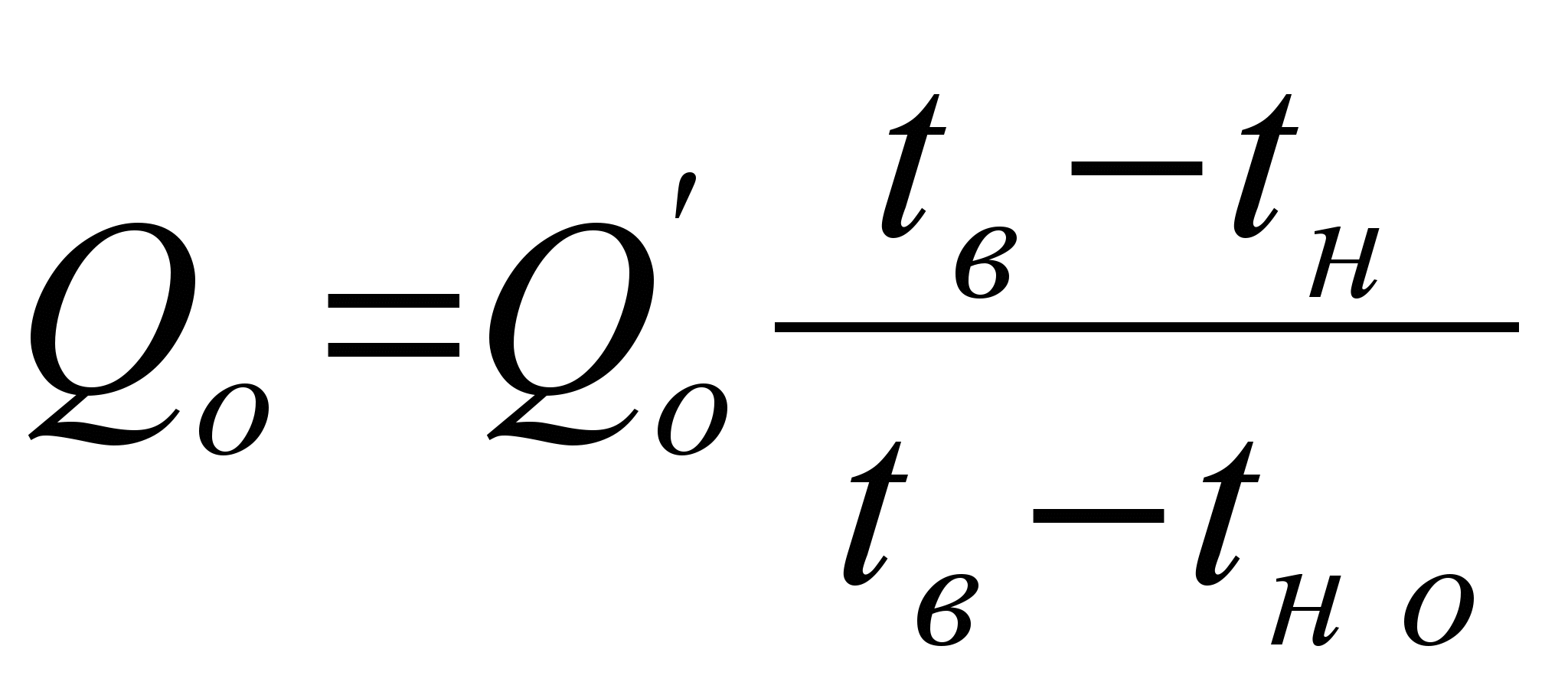 .
.
For economical use of fuel, the correct choice of the beginning and end of the heating period is of great importance. According to SNiP, the beginning and end of the heating period is accepted at the average daily temperature equal to +8 0 C. For industrial premises with internal heat generation, the heating period begins at the outside air temperature at which  .
.
For industrial buildings:
At t n t but
When t n > t but
![]()
D  The duration of the heating period is determined by the number of days with a stable average daily temperature less than and equal to +8 0 C.
The duration of the heating period is determined by the number of days with a stable average daily temperature less than and equal to +8 0 C.

2
1 – for residential and public buildings;
2 – for industrial buildings.
Fig.1.1. Heat supply schedule for heating.
Determination of heat consumption for heating by building area

 ,
,where q F is heat output per 1 m 2 of building area, W/m 2; F - building area, m2.
F = f beat z, where z is the number of residents;
fsp = 12.5 m 2 / person – for buildings built before 1980; fsp = 18 m 2 / person – for buildings built after 1980;
k 1 =0.25 is a coefficient that takes into account heat supply for heating public buildings. When t n > t but
1.1.2. Calculation of heat supply for ventilation
The ventilation load is understood as the need for heat to heat the air supplied from outside to the premises. In residential buildings without special supply system ventilation heat consumption Q in = 0.
For public and industrial buildings:
Q V = C'V V (t V -t n ) m ,
Where WITH'- volumetric heat capacity of air, 1260 J/(m 3 K);
V V- volume of the ventilated room according to internal measurements;
m- rate of air exchange in the room.
When calculating using aggregated indicators, heat supply is determined with a known
volume of the building.
Q V = q V V(t V -t n ).
For public buildings located in a residential area

Where k 2 = 0.4 - for old buildings, k 2 = 0.6 - for new buildings.
A - with a slight release of harmful substances. The maximum heat supply for these buildings is determined by the design temperature for ventilation - t nv- average temperature of the coldest period, constituting 15% of the duration of the heating season.

At 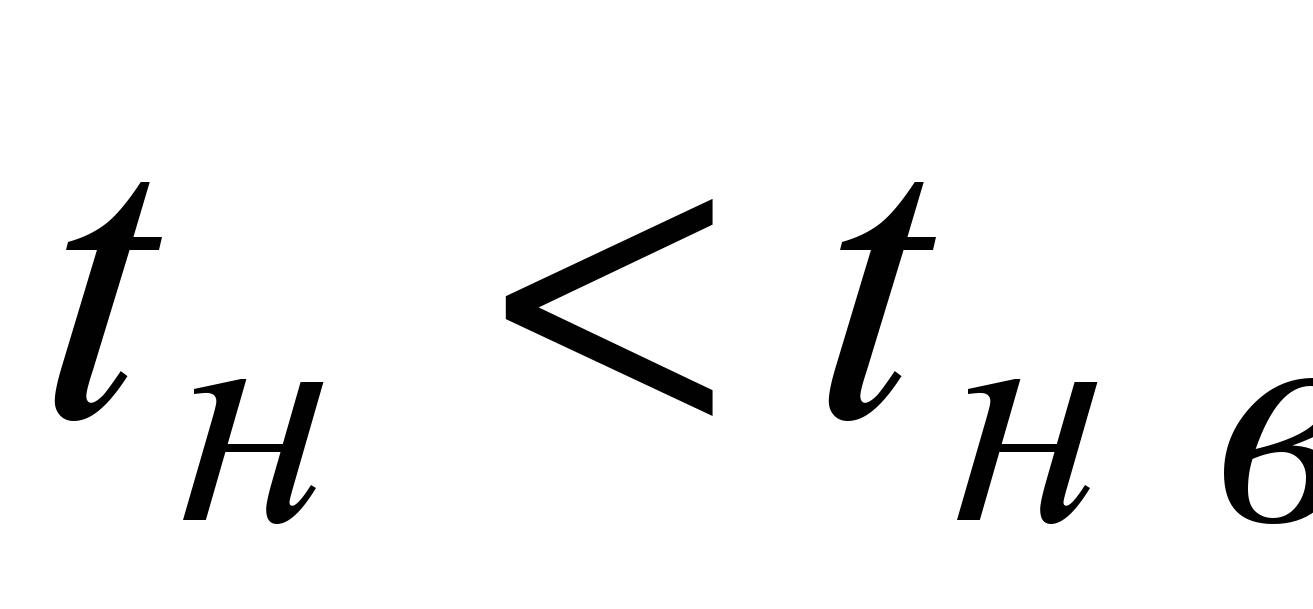 heat release for ventilation does not increase, while the air exchange rate decreases. The exchange rate reaches its minimum value at
heat release for ventilation does not increase, while the air exchange rate decreases. The exchange rate reaches its minimum value at 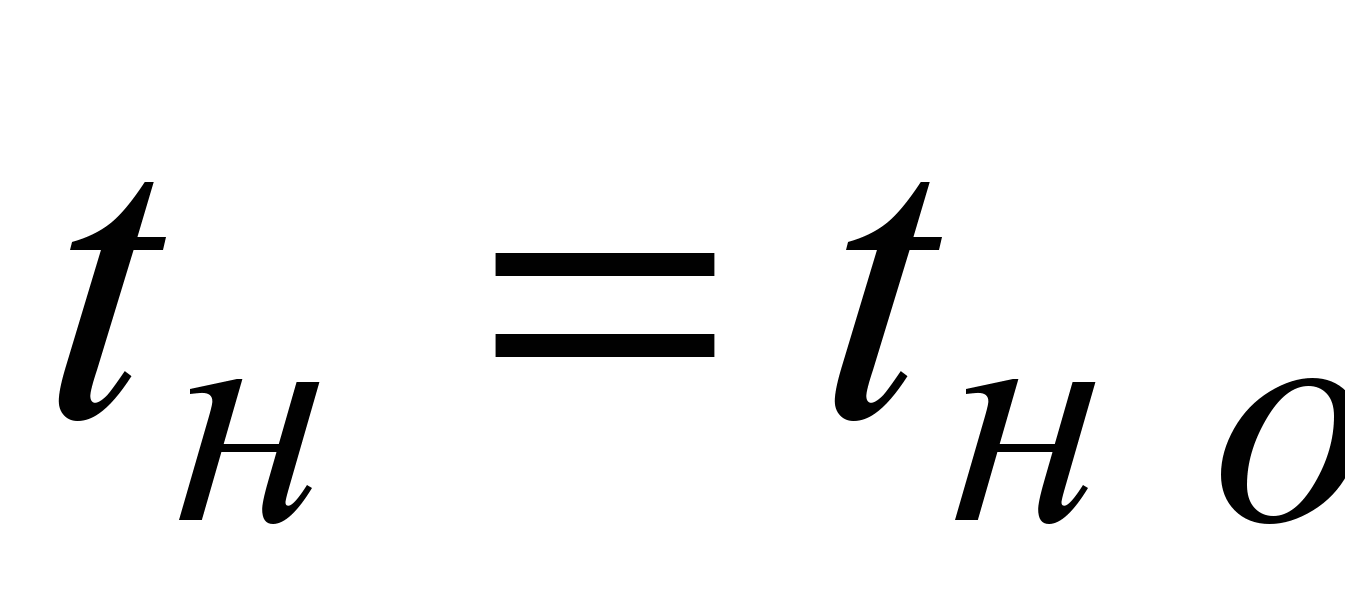 .
.
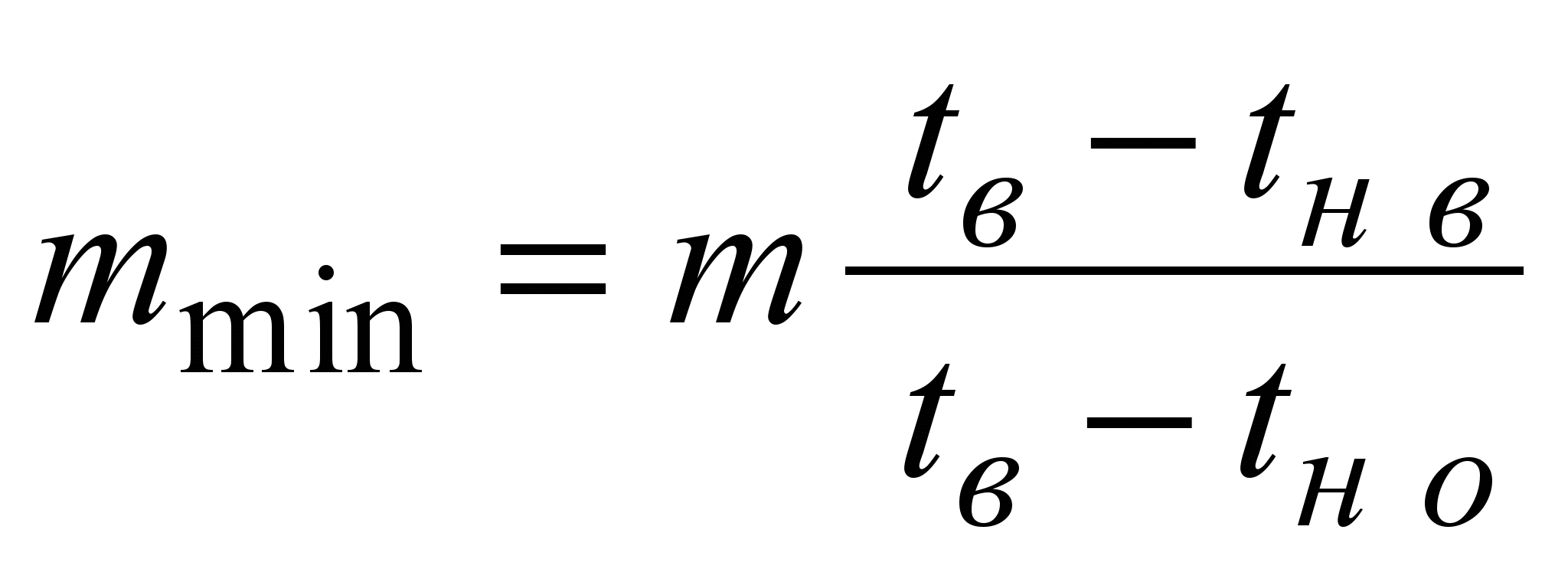 .
.
At 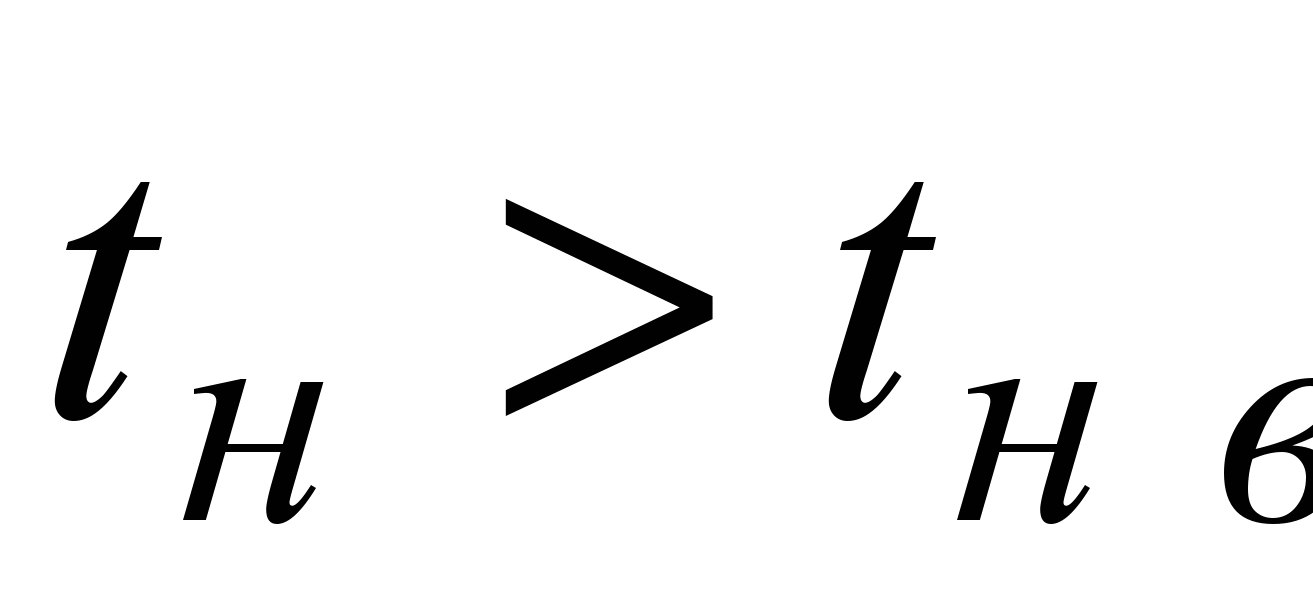
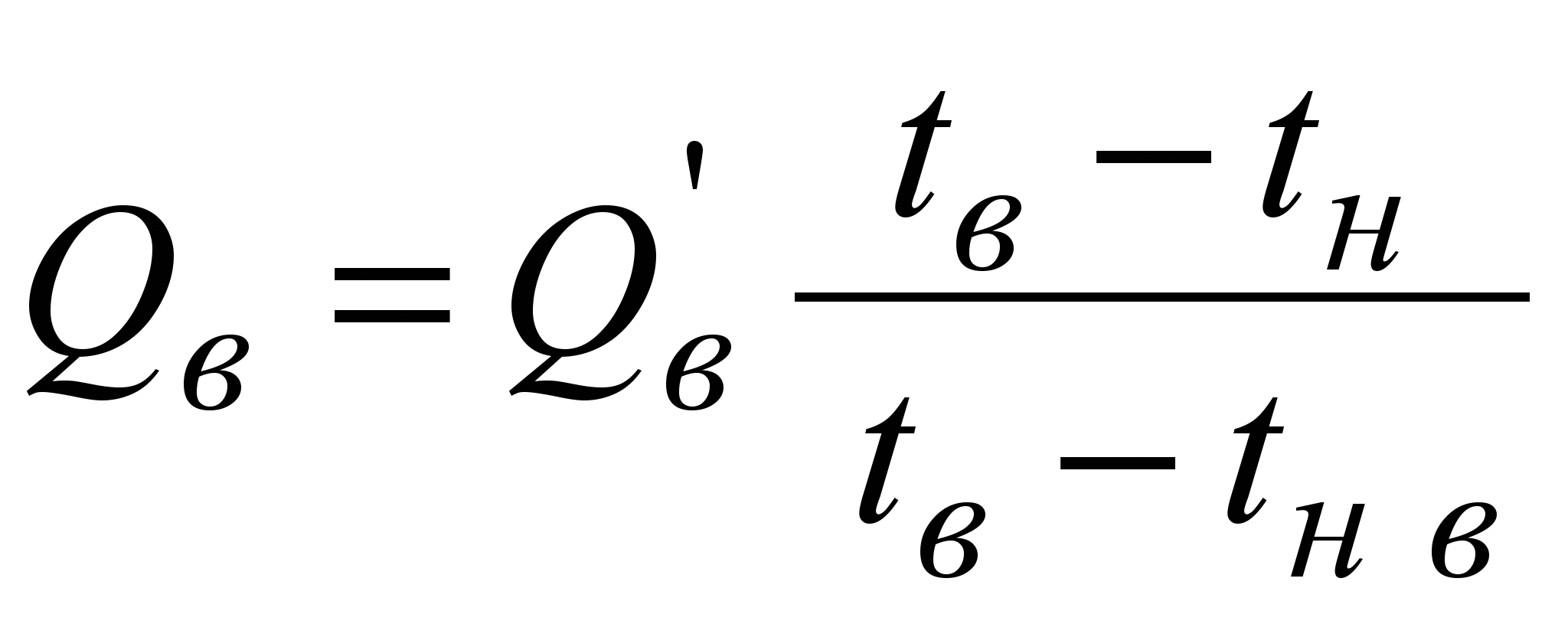 .
.
B - buildings with significant emissions of hazardous substances:

B - with special technical justification (a lot of harm)  determined by the average temperature of the coldest day.
determined by the average temperature of the coldest day.

8 t nv t but t n, 0 C
Fig.1.2. Heat supply schedule for ventilation
The year-round load includes the process load and the DHW load. The technological load is set by technologists and depends on the type of production.
The DHW load is significantly uneven both during the day and by day of the week. The highest consumption of hot water is observed in the morning and evening hours, among the days of the week - on Saturday.
The average weekly heat consumption for domestic hot water supply of individual residential, public and industrial buildings is determined by the formula
 , Where
, Where 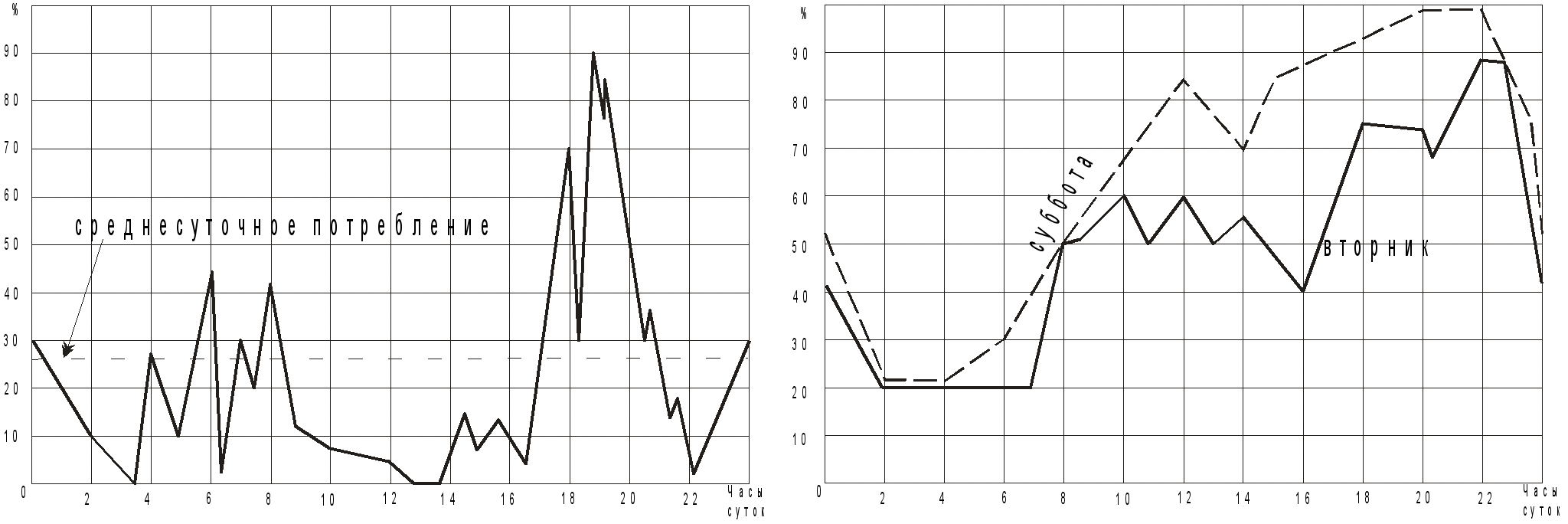
Fig.1.3. DHW heat consumption charts.
a –
hot water consumption rate t=60 0 C per unit of measurement; m– number of units of measurement; With– heat capacity of water, 4190 J/(kgK); t G ,
t X– temperature of hot and cold water; n c– estimated duration of water supply to the hot water supply system, sec./day. or hour/day In winter they accept t X
=5 0 C, in summer – t X=15 0 C. Value A given for
t G= 60 0 C. For other values t X
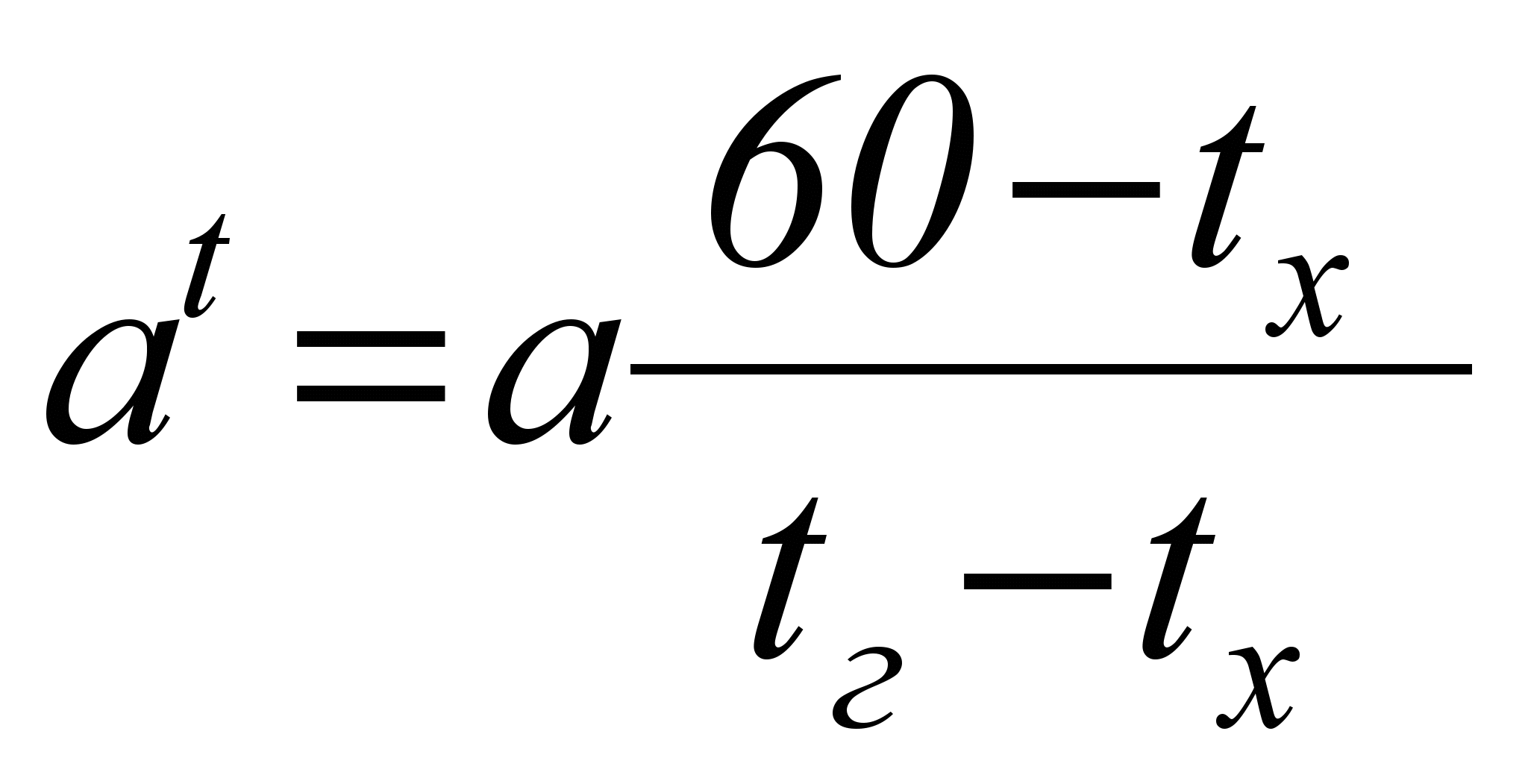 .
.
In places where water is collected, the hot water temperature for open systems must be maintained - not lower than 60 0 C and not higher than 70 0 C; for closed systems – not lower than 55 0 C and not higher than 75 0 C. For residential buildings, hospitals, kindergartens, sanatoriums, holiday homes, etc. n c =86400 seconds/day, or 24 hours/day. In the absence of data on the number and type of residential and public buildings in new areas, the average weekly heat consumption for hot water supply can be determined using the formula
A=80…120 l/day per person for residential buildings, V=18...22 l/day per person for public buildings. In summer
 .
.
The average heat consumption for hot water supply per day of greatest water consumption is equal to  , Where
, Where  - coefficient of weekly unevenness, equal to 1.2 for residential and public buildings. For industrial buildings =1. The estimated (maximum hourly) heat consumption for hot water supply is
- coefficient of weekly unevenness, equal to 1.2 for residential and public buildings. For industrial buildings =1. The estimated (maximum hourly) heat consumption for hot water supply is  . Here
. Here 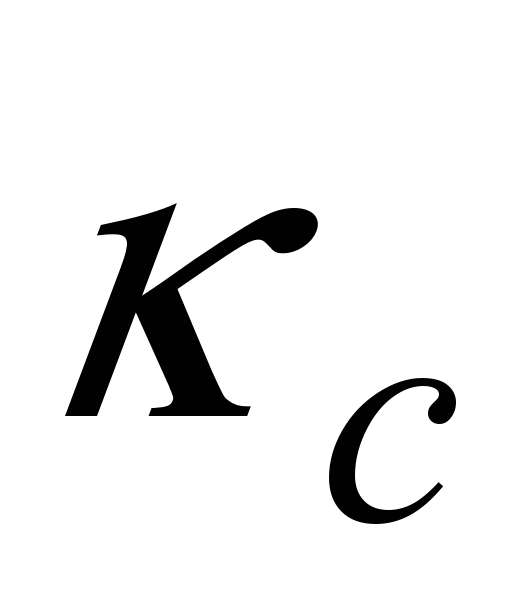 - coefficient of daily unevenness. For cities =1.7…2.2, for industrial buildings =1.
- coefficient of daily unevenness. For cities =1.7…2.2, for industrial buildings =1.
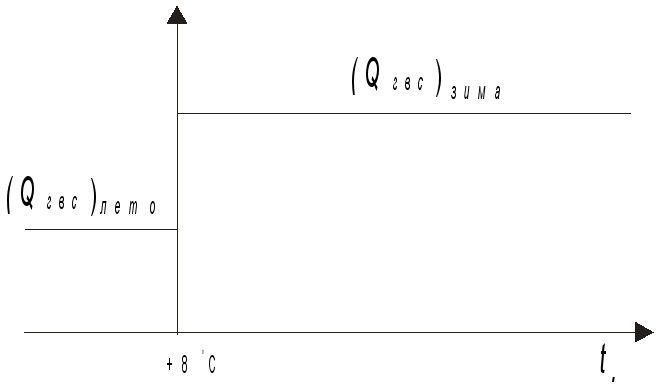
Fig.1.4. Heat supply schedule for hot water supply
Based on the method of supplying heat to DHW, open and closed heat supply systems are distinguished.
IN open systems DHW is supplied with water from the heating network.
Subscriber input scheme:
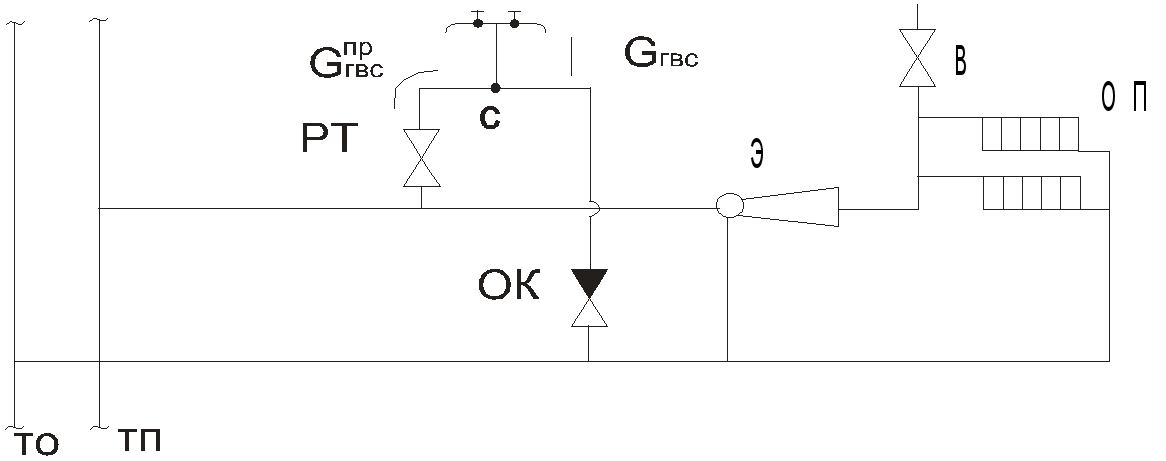
OK - check valve; E - water jet ejector or elevator; RT - temperature controller; B - air vent; OP - heating device; C - mixer.
Fig.1.5. Open connection scheme for subscriber installation
IN closed systems network water is used to heat secondary water entering the DHW system, i.e. Water-water heaters 1 or 2 are installed at the subscriber input of closed systems. Their connection can be single-stage or two-stage, made using parallel, two-stage serial or two-stage mixed circuits.
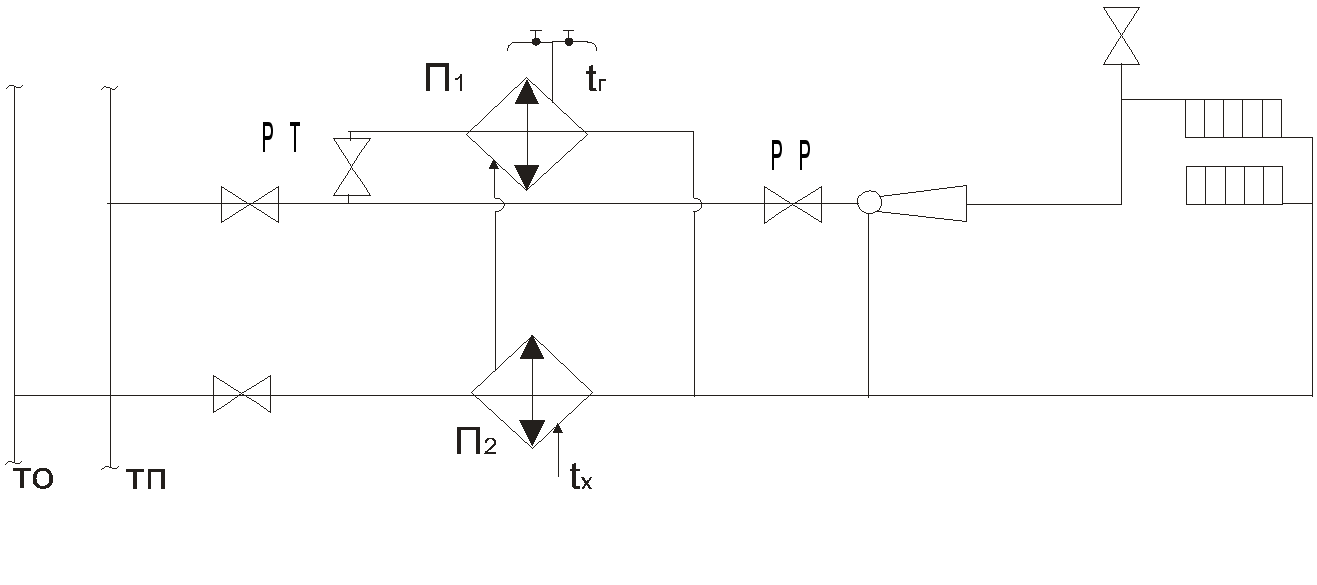
Fig.1.6. Two-stage sequential connection scheme for a hot water supply system
1.2. Calculation of annual heat supply. Heat load duration graph.
To construct a graph, you need data on temperature conditions. Given in reference books:
40...-35 0 C - n 1 hours;
35...-30 0 C - n 2 hours;
30...-25 0 C - n 3 hours;
......................……………
0...+5 0 C - n i-1 hours;
5...+10 0 C - n i hours.
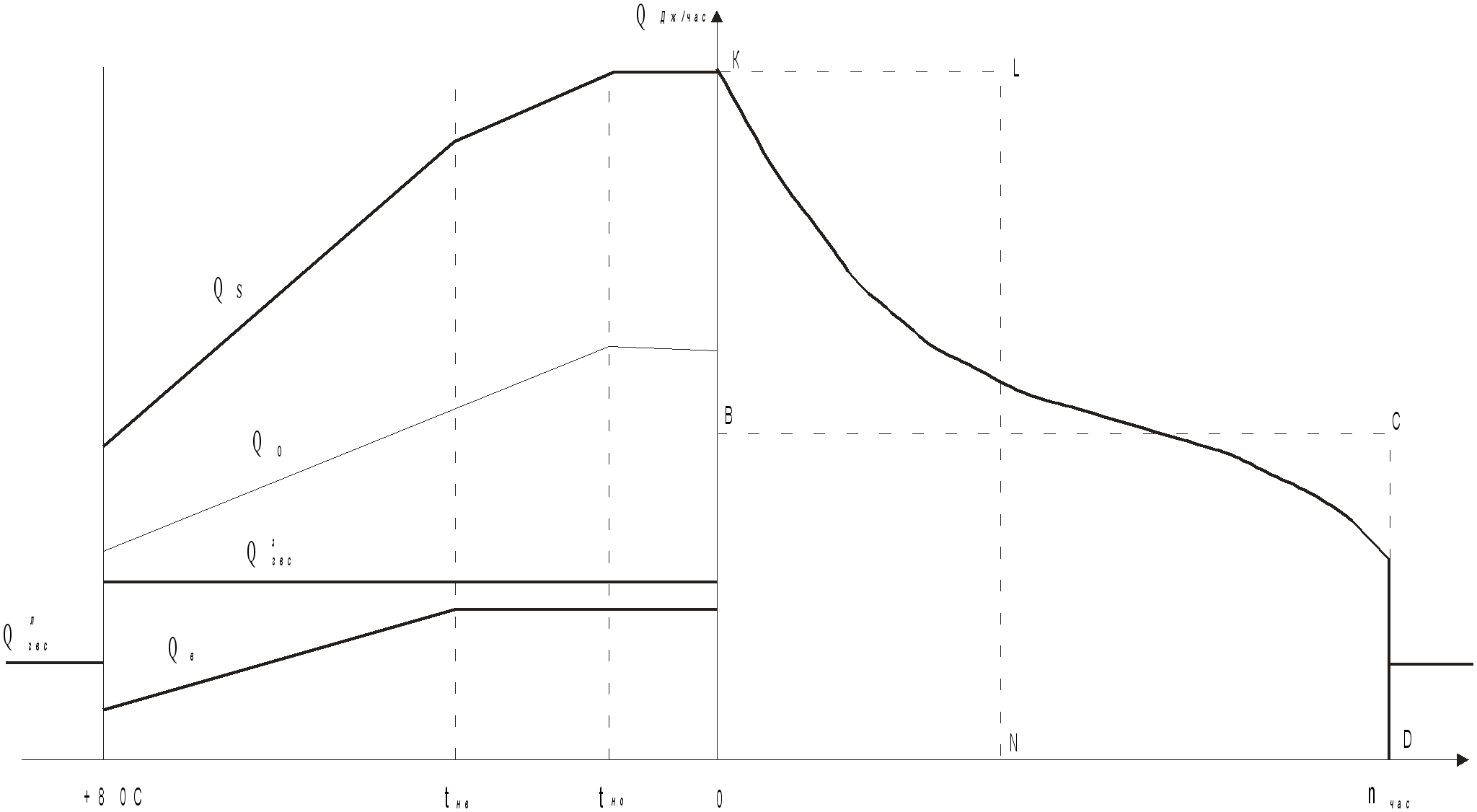
Fig.1.7. Graph of duration of total thermal load
The abscissa axis shows the number of hours during which a temperature equal to or less than a given temperature is observed. The hourly heat consumption is plotted along the y-axis. Let's construct two rectangles on the graph, the area of which is equal to the area of the graph. Then for rectangle 0BCD0 the height CD is equal to the average heat consumption for the heating period. For rectangle 0KLN0, segment 0N represents the duration of use of the design heat load for the season.
If the heat load is provided from various sources, then it is convenient to use the integral graph. The duration graph of the total thermal load is divided into equal intervals along the ordinate. a – relative thermal load. a c =  - the ratio of the heat load of the i-th source to the calculated load of the area.
- the ratio of the heat load of the i-th source to the calculated load of the area. 
 - the ratio of the amount of heat from the source per season to the total heat consumption for the season. Then the area 0abc0 is equal to the heat consumption from the source, the power of which is equal to 20% of the calculated one, i.e.
- the ratio of the amount of heat from the source per season to the total heat consumption for the season. Then the area 0abc0 is equal to the heat consumption from the source, the power of which is equal to 20% of the calculated one, i.e.  .
.
Integrated graphs constructed for any one geographic location can be used with sufficient accuracy for the entire climate zone. 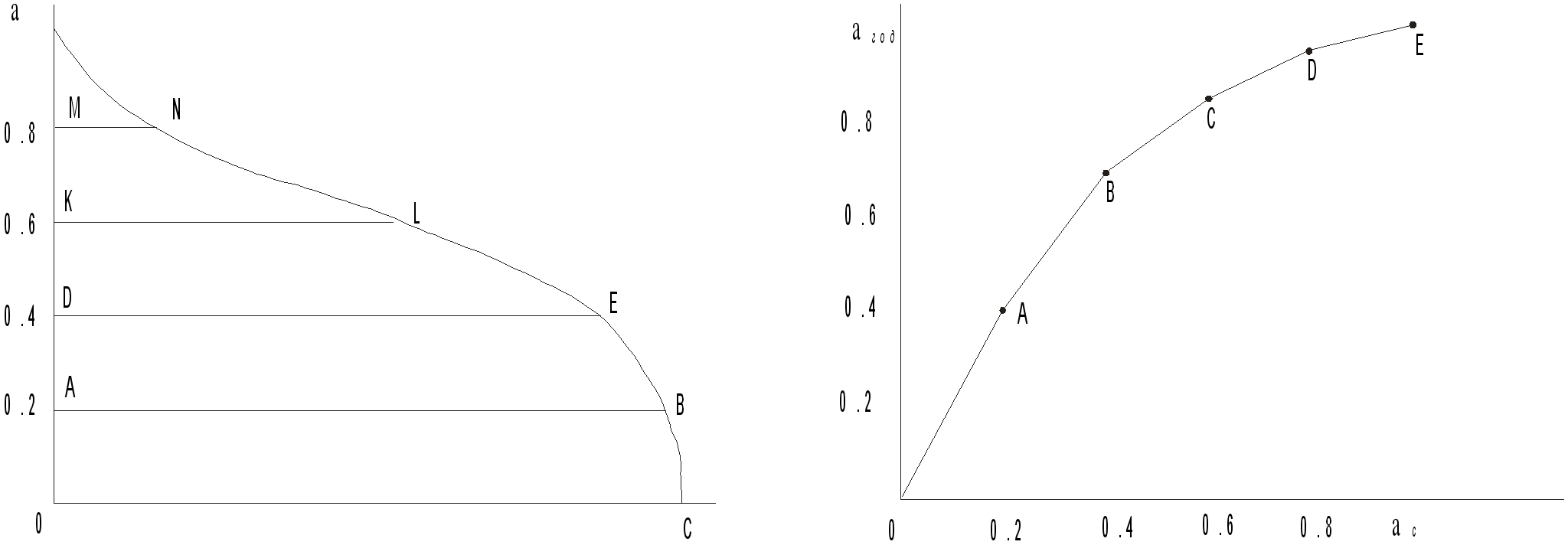
Fig.1.8. Integral graph of thermal load
F 0
abc 0
/
F=0.4 – point A. At  we get
we get  - t.V, etc.
- t.V, etc.
For example, there are two heat sources. One has power equal to 60% of maximum consumption,  . Another is able to cover the remaining 40%. In this case, the first source can provide 92% of the maximum heat demand, the second - 8%.
. Another is able to cover the remaining 40%. In this case, the first source can provide 92% of the maximum heat demand, the second - 8%.
1.3. Water heating systems
Water heating systems are divided into open and closed. In open systems, water is taken from the heating network for DHW needs. In closed systems, water for domestic hot water needs is heated by network water in heat exchangers. Connection diagrams for DHW installations are shown in Fig. 1.5, 1.6. Based on the number of pipelines, TS systems are divided into one-, two-, three- and multi-pipe. An open vehicle system must have at least one pipe. In a closed system, at least two pipes are required. In cities, in most cases, two-pipe systems are used. They are used if all consumers need heat at approximately the same potential. Where a higher potential load is also required, a three-pipe system is used. In this case, two lines are supply lines, and one is return line. Depending on the nature of subscriber installations, one or another scheme for connecting them to the heating network is selected.
Heating installations can be connected according to dependent and independent circuits. With dependent connection, the water circulating in the heating system is heated in the heat exchanger by water from the heating network. In a dependent circuit, water is supplied to the heating devices from the heating network. In this case, there is a rigid hydraulic connection between the heating system and the heating network. Maximum pressure in heating installation limited by the strength of heating devices. Reliability dependent systems small.
2. REGULATION OF HEAT LOAD
The heat load changes during the heating season. Therefore, to maintain the required thermal conditions, the thermal load must be adjusted.
There are central, group, local and individual regulation. Central regulation is carried out at thermal power plants and boiler houses. Group - at group thermal substations. Local - at local thermal substations. Individual – directly from subscribers.
If the heat load of all consumers is approximately the same, then we can limit ourselves to central regulation. In most cases, the heat load is non-uniform. In this case, central regulation is carried out according to the characteristic heat load for the majority of consumers. First of all, this is the heating load and the combined load of heating and domestic hot water. In the second case, the water consumption in the vehicle increases slightly compared to regulation based on the heating load or does not change.
The main amount of heat in subscriber systems is spent on heating. Therefore, the thermal load primarily depends on the heat transfer mode. Heat transfer is described by the heat transfer equation
 (2.1)
(2.1)
Where n- duration of system operation; F– heat exchange surface area; k- heat transfer coefficient; D have limitations. The temperature of the network water cannot be lower than 60 0 C, necessary to ensure the temperature DHW water and cannot be higher than the saturation temperature for a given pressure. Water flow is determined by the available pressure drop across the GTP and MTP. If one of the coolants is steam, then its temperature can be changed by changing the pressure (throttling).
In water systems, you can actually change the thermal load in three ways:
changing the temperature of the network water - quality regulation;
changing the flow of network water - quantitative regulation;
changing water flow and temperature - qualitative and quantitative regulation.
The choice of control method depends on the hydraulic stability of the system. Hydraulic stability is the ability of the system to maintain a given hydraulic mode and is characterized by the hydraulic stability coefficient

Here 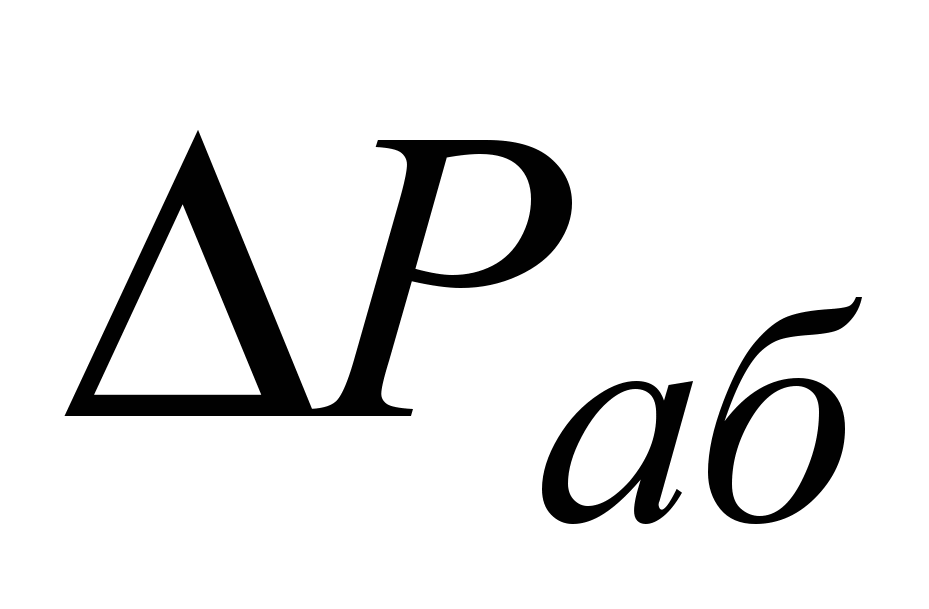 - available pressure drop at the most distant consumer;
- available pressure drop at the most distant consumer;
.
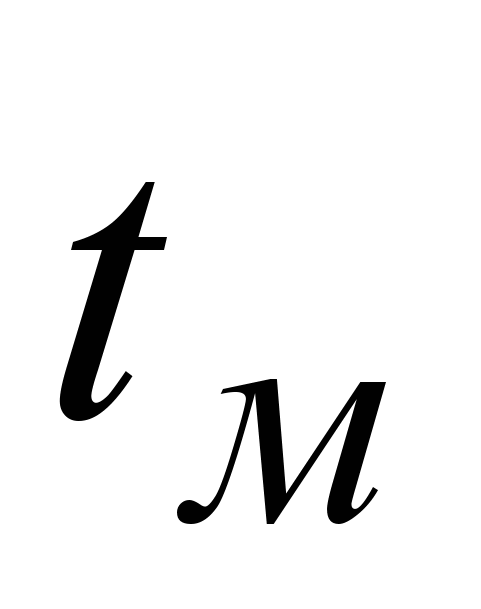 (2.4)
(2.4)
In equation (2.3)
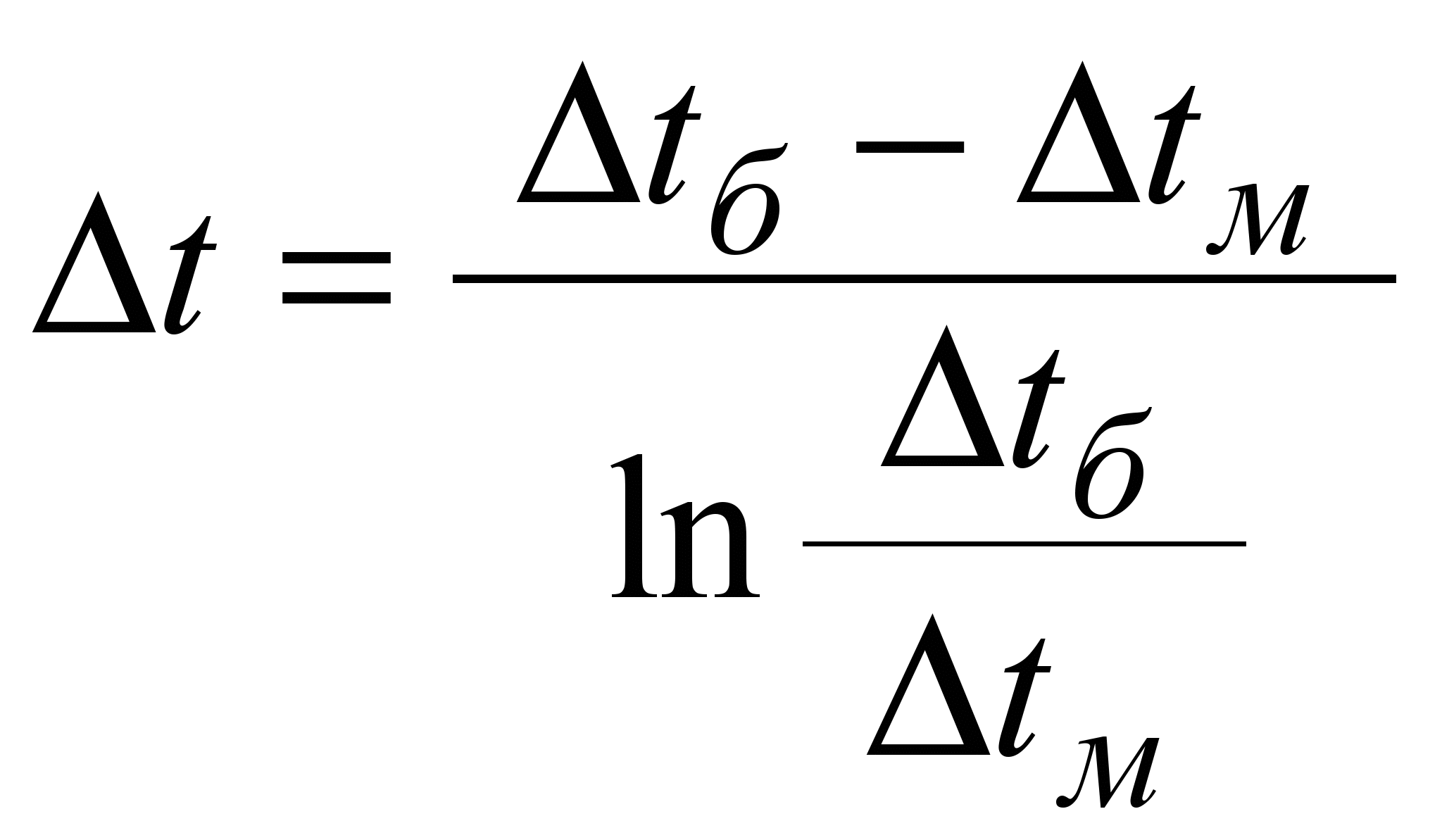 (2.5)
(2.5)
If 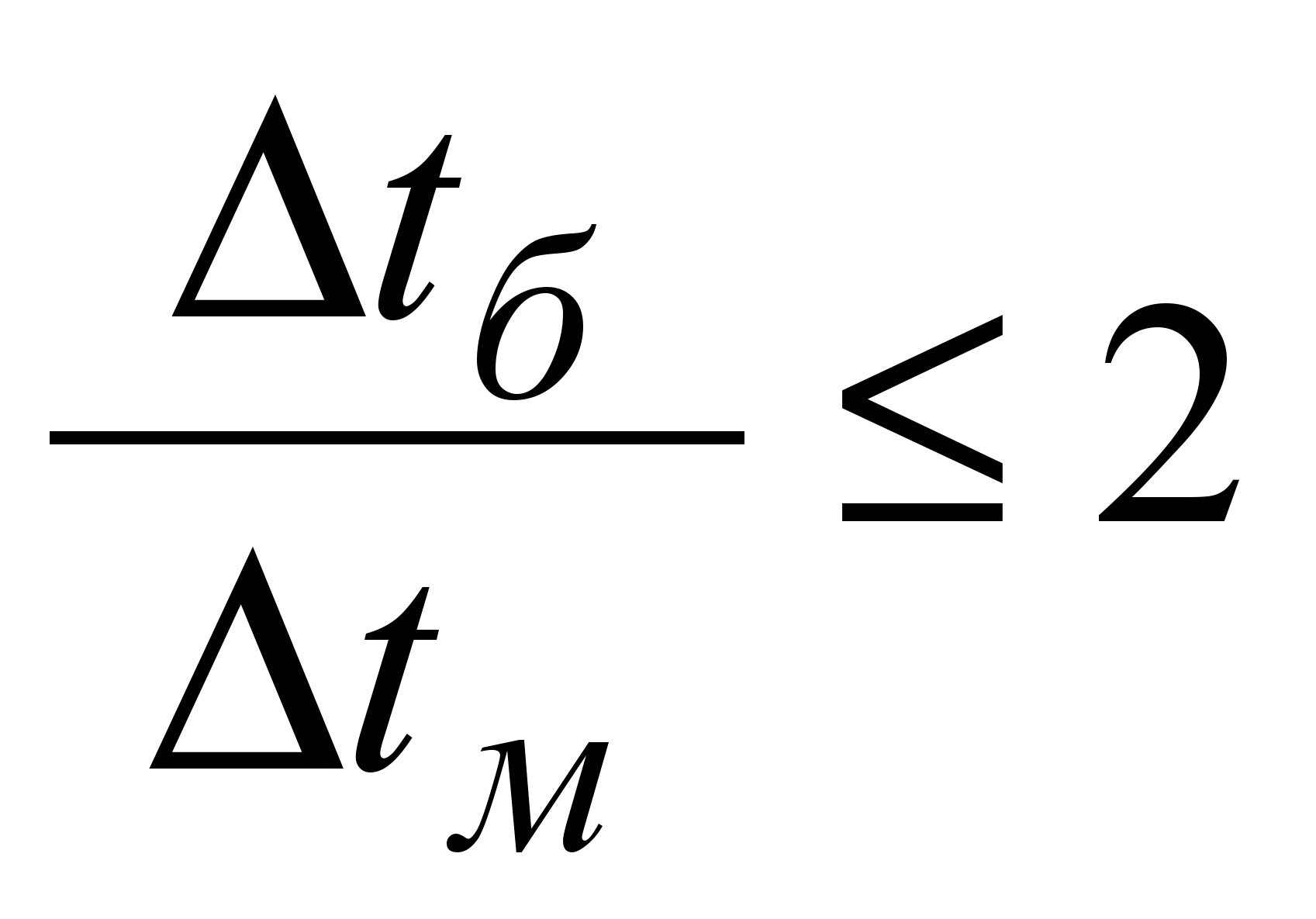 , then you can use the arithmetic mean temperature difference.
, then you can use the arithmetic mean temperature difference.  . (2.6)
. (2.6)
For the purposes of calculating heat load regulation, equation (2.3) is inconvenient, because advance value D
(Document)
n1.doc
I Course of lectures for the first half of the yearSources and systems of heat supply for enterprises
Heating systems manufacturing enterprises
Types of thermal loads
Classification of heat supply systems
By type of coolant (steam systems and water systems);
According to the method of supplying heat to the consumer; (for heating: dependent and independent ; for hot heating:closed and open )
By the number of parallel running heat pipes;
According to the number of connection stages.
4. Heat network diagrams (dead-end, radial, ring)
5. Steam heat supply systems (SHS).
6. Heating networks equipment
Heat supply systems for enterprises (STSPP)
is a complex of devices for the production, transportation and provision of consumers required quantity heat of the required parameters.
The heat supply system (Fig. 1) includes:
1. Source (CHP, boiler room);
2. Trunk networks (heat);
3. Distribution networks(thermal);
4. Heat consumers (industrial consumers,
Residential and public housing and communal services facilities);
5. Subscriber input (heating unit, local MTP heating unit, elevator unit);
6. Central heating point of the central heating station.
Fig.1. Heat supply system.
Types of thermal loads:
Heat load consumption:
ventilation (heat in the heater (heat exchanger);
hot water supply;
technological needs pp.
Thermal loads are distinguished:
seasonal (heating, ventilation);
year-round (hot water supply, technological needs).
according to the heat supply scheme to the consumer;
by type of coolant;
by the method of supplying heat to the consumer;
by the number of parallel running heat pipes;
according to the number of connection stages.
Decentralized - heat source at the point of consumption. In this case, there are no heating networks; are used in areas with low concentration of heat load, when small buildings are located on sparsely built-up areas, as well as during feasibility studies.
Centralized - the source of heat supply (CHP or boiler house) is located at a considerable distance from heat consumers. Therefore, each heating system consists of three links (heat source – heating networks – local heat supply systems). Local STS - thermal substations and heat receivers.
Centralized heating systems have advantages over decentralized ones, and currently C T determine the leading role in the development of heat supply to large cities and industrial enterprises. In Petrozavodsk the thermal power plant was put into operation in 1977.
2. By type of coolant:
Steam systems (coolant - water vapor);
Water systems (coolant - hot water).
Hot water is used to meet heating, ventilation and hot water loads. Water steam is used in enterprises for technological needs (superheated water is rarely used). At the required coolant temperature of the consumer up to 150˚C, hot water is used, and at higher parameters, water steam is used. There are special requirements for coolants:
A. sanitary and hygienic (in housing and communal services premises the temperature of heated devices is not allowed above 90˚C, in industrial workshops it can be higher);
B. technical - economic (the cost of material, installation and operation should be optimal);
B. operational (the coolant must have qualities that would allow centralized regulation of the heat transfer of consumption systems).
Comparative characteristics of water and steam as a coolant:
Advantages of water: temperature range over a wide range (from 25˚ to 150˚С); the possibility of transportation over long distances without reducing its thermal potential (15-20 km); the possibility of centralized control of the coolant temperature at the source; ease of connecting local systems to heating networks.
Disadvantages of water: significant energy consumption is required to operate pumps to pump heat; The coolant temperature may be less than the set one.
Advantages of steam: used both for heat consumers and for power and technological needs; rapid heating and cooling of the system, which is valuable for rooms where heating is periodically required; in steam systems, hydrostatic pressure can be ignored due to the low bulk density (1650 times less than the volume of water). Steam systems can be used in mountainous areas and in multi-storey buildings; no energy consumption for steam transportation (without pumps); ease of initial adjustment due to self-adjustment of steam.
Disadvantages of steam: when transporting over long distances, large losses of temperature and pressure occur, so the radius of steam systems is only 6-15 km, and water systems - from 30 to 60 km. The service life of steam systems is significantly lower than that of water systems due to corrosion of the pipes.
3. According to the method of supplying heat to the consumer :
For heating - vehicle connection diagrams: dependent and independent;
For hot heat supply - vehicle connection diagrams: closed and open.
Dependent connection diagram - when water from the heating network directly enters the heating devices of the local heating system(MOS).
An independent connection scheme - when there are two separate circuits (primary - water circulating in the heating network, and secondary - the house’s own circuit, water circulating in the MOS), while water from the heating network transfers heat to the water of its own circuit through a heat exchanger. Water from the heating system reaches only the MWW thermal substation (a thermal substation is a central heating substation or MTP), where water is heated in heaters (TA heat exchangers), which circulates in the MWW. In this case, there are two coolants: heating (water from the heating system) and heated (water in the MOS). The pressure of the primary circuit is not transmitted in any way to the pressure of the secondary circuit, which operates due to its own circulation pump.
Open water supply - directly from the heating network. Closed water supply - through a heat exchanger, water from the vehicle heats drinking water.
The equipment of a thermal substation with a dependent circuit is simpler and cheaper than with an independent one, however, it must be taken into account that in dependent circuits, pressure is transferred from the heating network to the MOS, which can withstand pressure up to 6-10 atm. depending on the type of heating devices. Example: cast iron radiators withstand 6 atm.
Schemes for connecting heating systems to heating networks: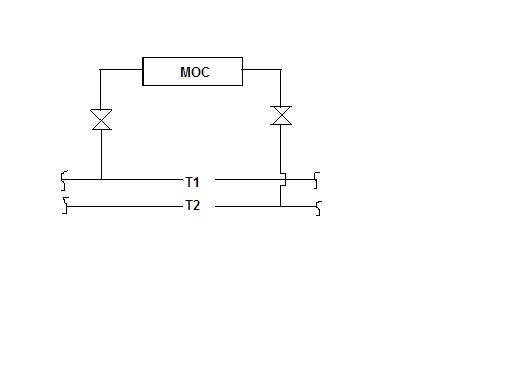
T 1 – heat supply pipe of the vehicle,
-1 -1 T 2 – return pipeline of the vehicle,
1 – disconnecting device fittings.
Rice. 2. Dependent circuit without mixing
The temperature in the vehicle supply pipeline does not exceed the limit established by sanitary standards for devices of local systems. This is possible in the case of a small heat source, when the boiler room produces coolant with parameters of 95˚-70˚C or in the heating system of industrial buildings t ? 100˚ C, but it is acceptable.
Dependent circuit with elevator mixing (Fig. 3).
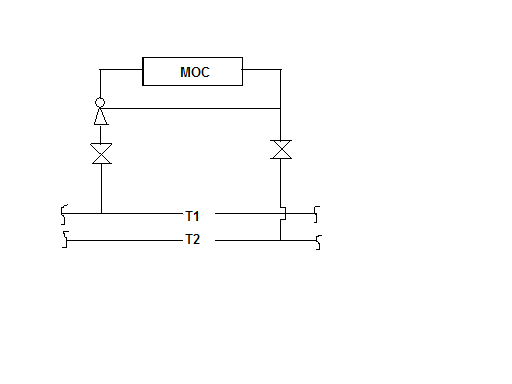
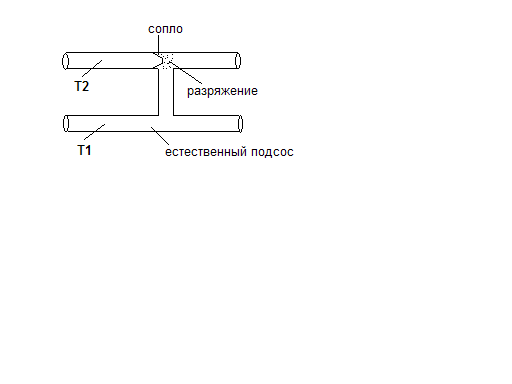
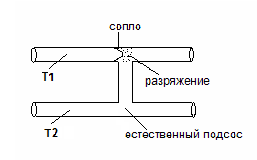
? 130˚С ? 90-95˚С
70˚С?
Rice. 3. Dependent circuit with elevator mixing Fig. 4. Elevator
Water from supply pipe T 1 s t = 130˚ C enters the elevator (Fig. 4), water from the return local network T is sucked through the pipe to the elevator 2 t =70˚ C . Thanks to the nozzle, which is built into the elevator, and according to the injection principle, mixing occurs t = 130˚ C and t =70˚ C, mixed water t = 90˚С enters the heating devices. Elevators are calculated and the nozzle diameter is selected. In our country, most of the inputs to buildings are equipped with elevators where superheated water is transported through heating networks. It must be taken into account that for the elevator to operate, a water pressure of 15 m of water column is required.
Dependent circuit with pump mixing (Fig. 5).
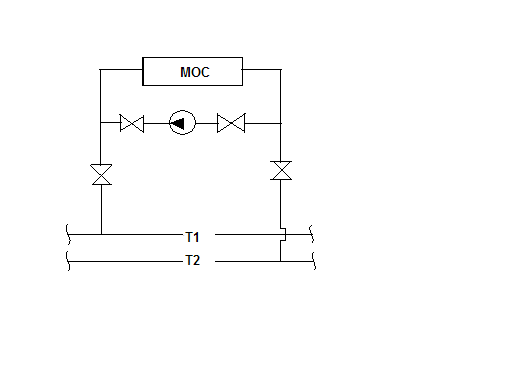 In case of insufficient pressure, set
In case of insufficient pressure, setCentrifugal pump on a jumper between
90˚С ? 70˚С ? supply and return pipelines and it
How the elevator mixes the supply water
Reverse chilled water. But the pump
Expensive equipment.
130˚С? There is a scheme with both an elevator and a pump.
Rice. 5. Dependent circuit with pump mixing
Independent circuit (with heat exchanger) (Fig. 6).
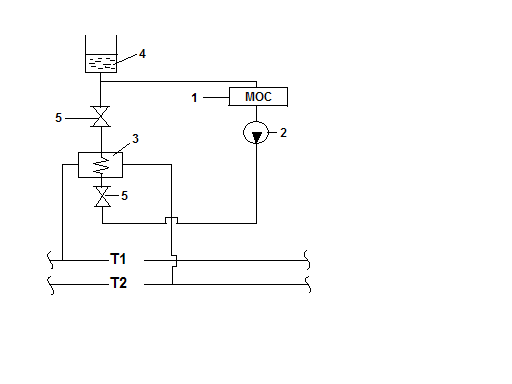 An independent circuit divides the MOS into two circuits, preventing pressure fluctuations. Both circuits are hydraulically isolated and independent of each other. In this scheme, it is easy to take into account the need for heat, regulate the heat supply, i.e. eliminate the problem of overheating, and, therefore, save money.
An independent circuit divides the MOS into two circuits, preventing pressure fluctuations. Both circuits are hydraulically isolated and independent of each other. In this scheme, it is easy to take into account the need for heat, regulate the heat supply, i.e. eliminate the problem of overheating, and, therefore, save money. 1. Local heating system;
2. Circulation pump;
3. Heat exchanger;
4. Expanded tank;
5. Shutdown valves.
Rice. 6. Independent circuit (with heat exchanger)
Schemes for connecting hot water supply to heating networks.
In closed heating systems The coolant is completely returned to
Closed circuits distinguish between single-stage and multi-stage. The choice of scheme depends on the ratio of heat consumption for heating and domestic hot water. The choice of connection scheme is made based on calculations.
In open systems DHW uses not only the heat supplied
Schemes for connecting hot water supply systems of buildings to heating networks.
Single-stage circuits (Fig. 7, 8):
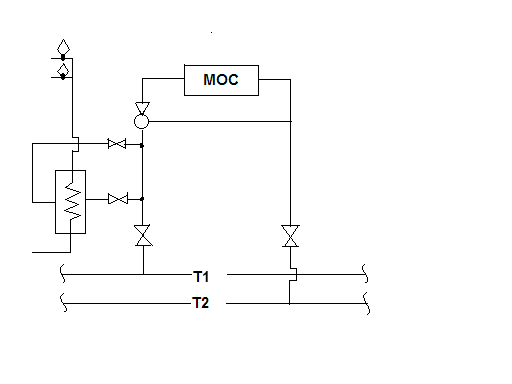
One heat exchanger and heating for DHW occurs before the MOS).
Rice. 7. Single stage pre-connected
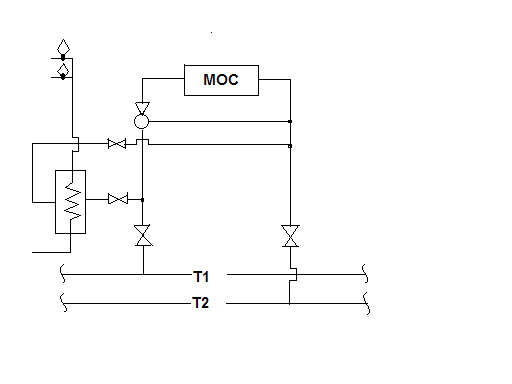
?
Rice. 8. Single stage parallel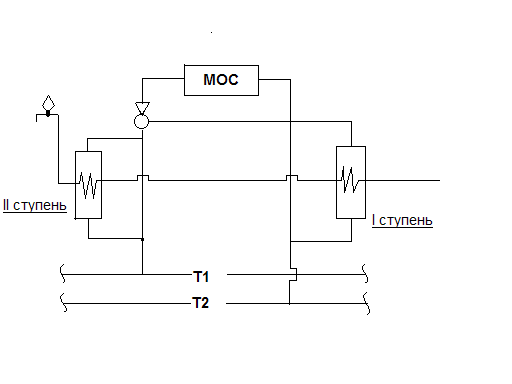
T = 55-60˚С
Т = 30˚С Т = 5˚С
Rice. 9. Sequential two-stage
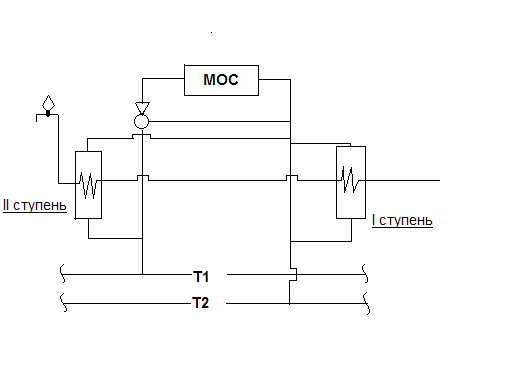
Rice. 10. Mixed two-stage
Two-stage schemes are effective in application because there is a deep decrease in the temperature of the return water, and there is also an independent heat consumption for heating and hot water supply, i.e. fluctuations in flow rate in the DHW system do not affect the operation of the MOS, which can occur in open circuits.
4. By the number of parallel running heat pipes.
Depending on the number of pipes transmitting the coolantin one direction There are one-, two- and multi-pipe vehicle systems. The minimum number of pipes can be:
An open single-pipe system is used for centralized heating for technological and domestic needs, when all network water is taken up by consumers when supplying heat for heating, ventilation and hot water supply, i.e. When Q from + Q vent. = Q hot water . Such situations are typical for southern regions and technological consumers (rarely encountered).
The two-pipe system is the most common and consists of supply (T1) and return (T2) pipelines.
Three-pipe - consists of a connection two-pipe system water supply for heating and ventilation and a third pipe for hot water supply, which is not very convenient.
Four-pipe - when a circulation pipeline is added to the hot water supply.
Symbols of pipelines in accordance with GOST:
supply pipeline (T 1 ),
return pipeline (T 2 ),
DHW pipeline (T 3 ),
DHW circulation pipeline (T 4 ),
pipeline for technological needs (TT).
There are single-stage and multi-stage schemes of heat supply systems.
Single-stage scheme (Fig. 11) – when heat consumers are connected to heating networks using MTP.
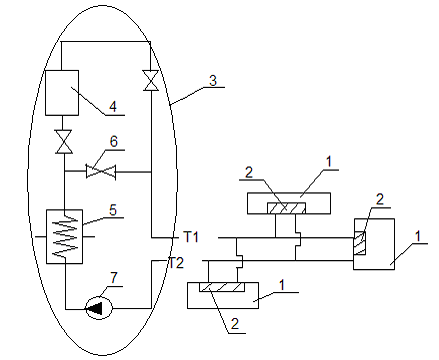
Rice. 11. Single-stage scheme
1- heat consumers,
2-local thermal units (MTP),
3- element of an industrial boiler house with steam and hot water boilers,
4- hot water boiler (peak),
5-network steam-water heater,
6- jumper with shut-off valves to create different operating modes (to turn off the hot water boiler),
7-network pump,
8- TsTP.
Two-stage scheme (Fig. 12).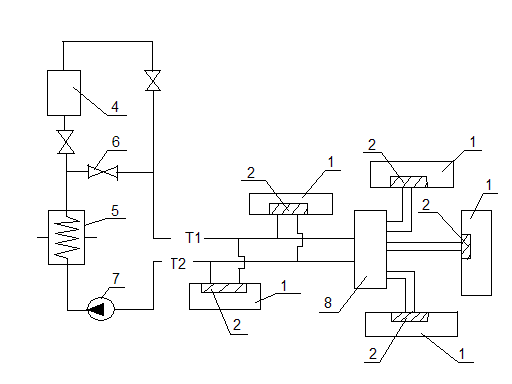
Rice. 12. Two-stage scheme
Multi-stage scheme - when central heating stations and group heating points (GTS) are placed between the heat source and consumers. These points are designed to prepare coolants of the required parameters, to regulate heat consumption and distribution to local consumer systems, as well as to account for and control the consumption of heat and water.
Heat network diagrams
Heat network diagrams depend on:
Placement of heat sources in relation to the area of consumption;
On the nature of the thermal load;
Depending on the type of coolant (steam, water).
Heat networks are divided into categories:
Backbone networks;
Distribution networks;
Intra-block networks;
Branches to consumers (buildings).
Dead-end (Fig. 13) - the simplest, is widespread in villages and small towns:
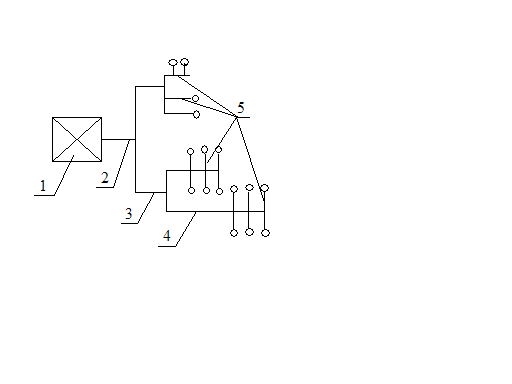 1-source,
1-source,
2-backbone networks,
3-distribution networks,
4-block networks,
5 branches,
6- consumers,
7-jumper.
Rice. 13 Dead-end circuit
Radial (Fig. 14) - arranged when it is not possible to provide a ring one, but a break in the heat supply is unacceptable:
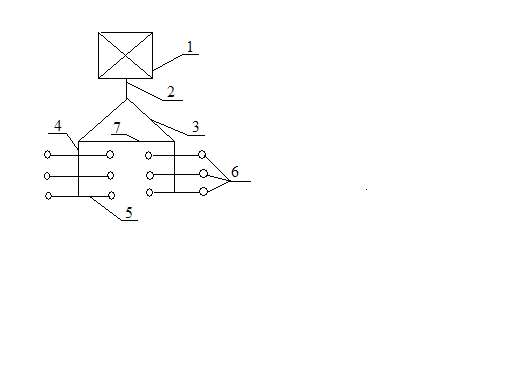
Rice. 14 Radial scheme
Ring - the most expensive, is built in large cities, provides uninterrupted heat supply, for which a second source of thermal energy must be provided:
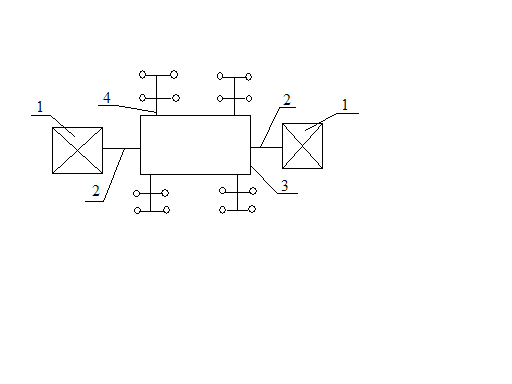
Rice. 15 Ring circuit
Steam heat supply systems (SHS).
Steam heat supply systems are used mainly at large industrial enterprises and can take place at facilities surrounding industrial consumers, as well as in cities with unfavorable terrain.
Types of steam systems:
1-pipe (Fig. 16) (no condensate return to the system):
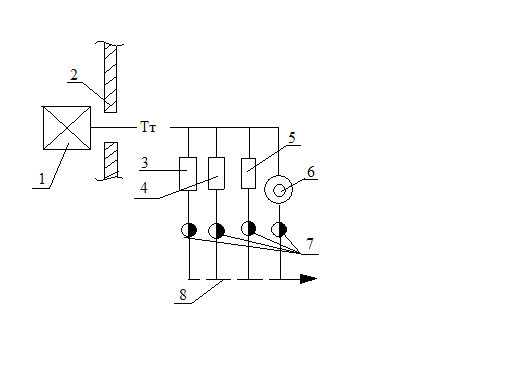 1-source (steam boiler),
1-source (steam boiler),
2-wall of an industrial consumer - the boundary of the consumer’s subscriber input,
3-heater,
5-steam-water heat exchanger for MOS,
6-technological unit,
Rice. 16 Single-pipe steam system7-condensate traps,
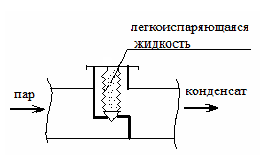 8- condensate discharge into drainage.
8- condensate discharge into drainage.
Rice. 17 Automatic condensate drain.
It is advisable to use a single-pipe scheme when, according to the conditions technological process The condensate has significant contamination and the quality of this contamination is ineffective for cleaning. This scheme is used for heating fuel oil and steaming reinforced concrete products.
2-pipe (Fig. 18):
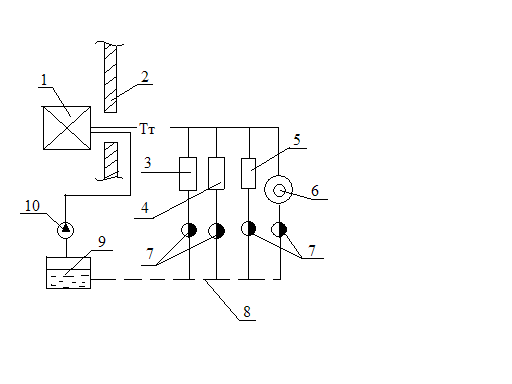 1-source (steam boiler),
1-source (steam boiler),
2-wall industrial
Consumer - border
Subscriber input of the consumer,
3-heater,
4-steam/water heat exchanger for
5-steam water heat exchanger for
6-technological unit,
7-condensate traps,
Rice. 18 Two-pipe steam system8-condensate line,
9-condensate tank,
10-condensate pump.
Two-pipe systems with condensate return are used if the condensate does not contain aggressive salts and other contaminants (i.e. it is relatively clean). The circuits are usually laid in such a way that condensate flows into the condensate tank by gravity.
3-multi-pipe (Fig. 19):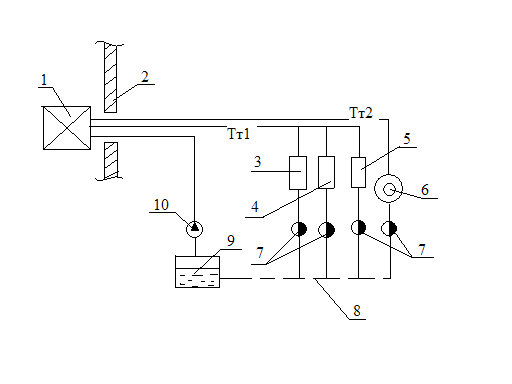
Rice. 19 Three-pipe steam system
The three-pipe (multi-pipe) circuit is used when the consumer requires a pair of different parameters. The boiler room produces steam with the maximum pressure and temperature required by one of the consumers. If there are consumers who require steam with lower parameters, then the steam is passed through a reducing unit (RU), in which steam only reduces pressure, or through a reducing cooling unit (RCU), if it is necessary to reduce both pressure and temperature.
Heating networks equipment
There are the following methods for laying heating networks:
Aboveground (ground) laying - takes place on the territory of industrial enterprises, at the intersection of roads and obstacles, in permafrost areas;
Underground installation can be:
In semi-passing channels,
In passage channels (collectors),
Ductless.
Collectors and semi-through channels take place in large cities, on the territory of industrial enterprises, where it makes sense to lay various engineering networks (communications) together. This installation method is convenient for network maintenance, but expensive. Heating network pipes laid in non-passable and ductless channels are not serviced. Thus, the choice of laying networks depends on the conditions of the territory, type of soil, development and feasibility study.
The depth of installation of heating networks depends on the location of installation. The maximum depth in the impassable part is 0.5 m to the top of the canal, in the roadway - 0.7 m. Heating networks are laid with a slope  ί
min =0.002 (ί min = h / L ).
ί
min =0.002 (ί min = h / L ).
Heating network equipment, which requires constant monitoring and maintenance, is installed in heating chambers (Fig. 20). These are: gate valves, butterfly valves, control valves, devices for releasing air and draining water (emptying the network). As a rule, fixed supports are built together with the camera. It is necessary to construct (in water-saturated soils) drainage networks (pipes with holes on top and sides are laid on the sand preparation and covered with crushed stone).
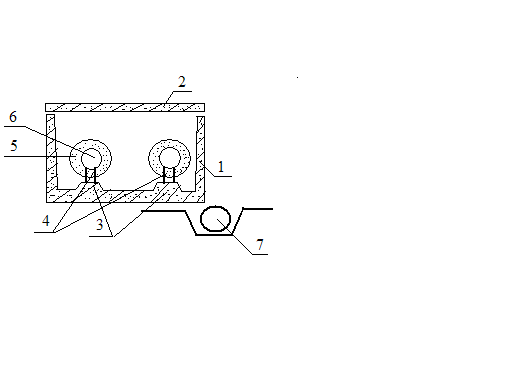
Rice. 20 Heating chamber
In heating networks, electric-welded or seamless pipes are used, and options are also possible cast iron pipes made of high-strength nodular cast iron.
For yard networks at operating pressure P slave up to 1.6 MPa and temperatures T up to 115˚C, non-metallic (plastic) pipes can be used.
Support structures.
There are: - movable (free) supports,
Fixed (dead) supports.
Movable supports are designed to support the weight of the pipe and ensure free movement of the pipes (during thermal expansion). The number of movable supports is determined from tables depending on the diameter and weight of the pipe. According to the principle of free movement, movable supports are divided into: sliding supports (slider), roller, ball, movable.
Movable supports are used in all installation methods, except channelless.
Fixed supports serve to absorb thermal deformation by securing the pipeline, as well as to delimit areas for compensation of thermal elongations. There are fixed supports:
Panel (for underground installation),
On a beam, on a foundation, on racks (for above-ground installation or in tunnels).
Compensation for thermal expansion.
Compensators are designed to absorb thermal expansion of the heat pipeline and unload the pipes from temperature stresses and deformations. The following types of compensators are used in heating networks: 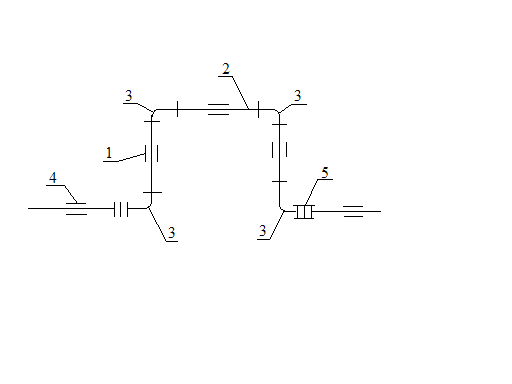
expansion joint,
compensator back,
welded steep bends,
movable supports,
coupling bolts,
 are installed onRice. 21 Flexible (U-shaped) supportclamps.
are installed onRice. 21 Flexible (U-shaped) supportclamps.∆l = ? ∙ L (? max - ? min), where ? – coefficient of linear expansion,
L – length between fixed supports (compensation section).
U-shaped expansion joints stretch by half the thermal elongation. Stretching is done at the first welded joints from the compensator.
U-shaped compensators, as well as rotation angles, do not require maintenance.
angles of rotation of the route (self-compensation),
bellows, lens (one or many corrugations),
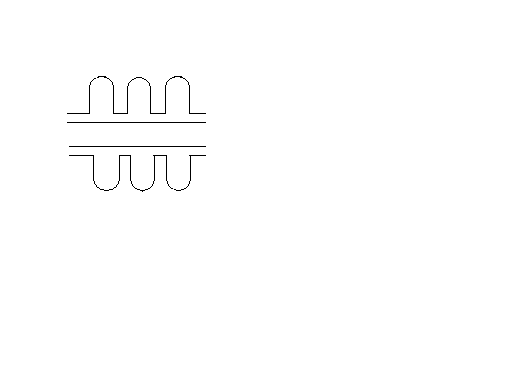 Compensating capacity of bellows compensator
Compensating capacity of bellows compensator It is 50-150 mm.
Bellows three-wave compensator.
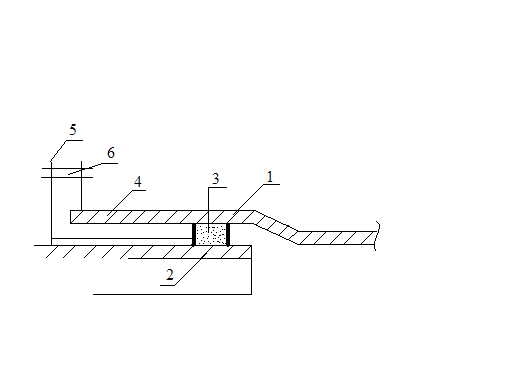
1-body,
2-glass,
3-gland packing,
4-groundbuks,
5-pressure flange,
6-pin bolt.
Rice. 22 Stuffing box compensator
The stuffing box compensator can be one-sided or two-sided.
Route rotation angles and U-shaped compensators operate as radial, and bellows, lens and stuffing box expansion joints operate as axial ones.
Channelless installation.
For ductless heating networks, pipelines with polyurethane foam insulation (PPU insulation) are used. Russia is the country with the most high level centralized heating supply, the length of heating networks in our country is approximately 260 thousand kilometers, and in Karelia - approximately 999 thousand meters. Of these, 50% of heating networks require overhaul. Heating networks lose 30% of the supplied heat, which is approximately 80 million tones/year. To solve these problems, a channelless laying with PPU insulation is proposed. Advantages of this gasket:
Increased durability from 10 to 30 years,
Reduction of heat loss from 30% to 3%,
Reduced operating costs by 9 times,
Reducing the cost of repairing heating mains by 3 times,
Reduced construction time,
Availability of an operational-remote control system (ODC) for the moistening of the insulating layer.
Statistics of accumulated defects:
38% - damage by third parties to the UEC system,
32% damage to steel shells,
14% - damage to butt joints,
8% ODK assembly errors,
2% - poor quality welding,
6% - internal metal corrosion.
For channelless installation, a polyethylene sheath is used.








